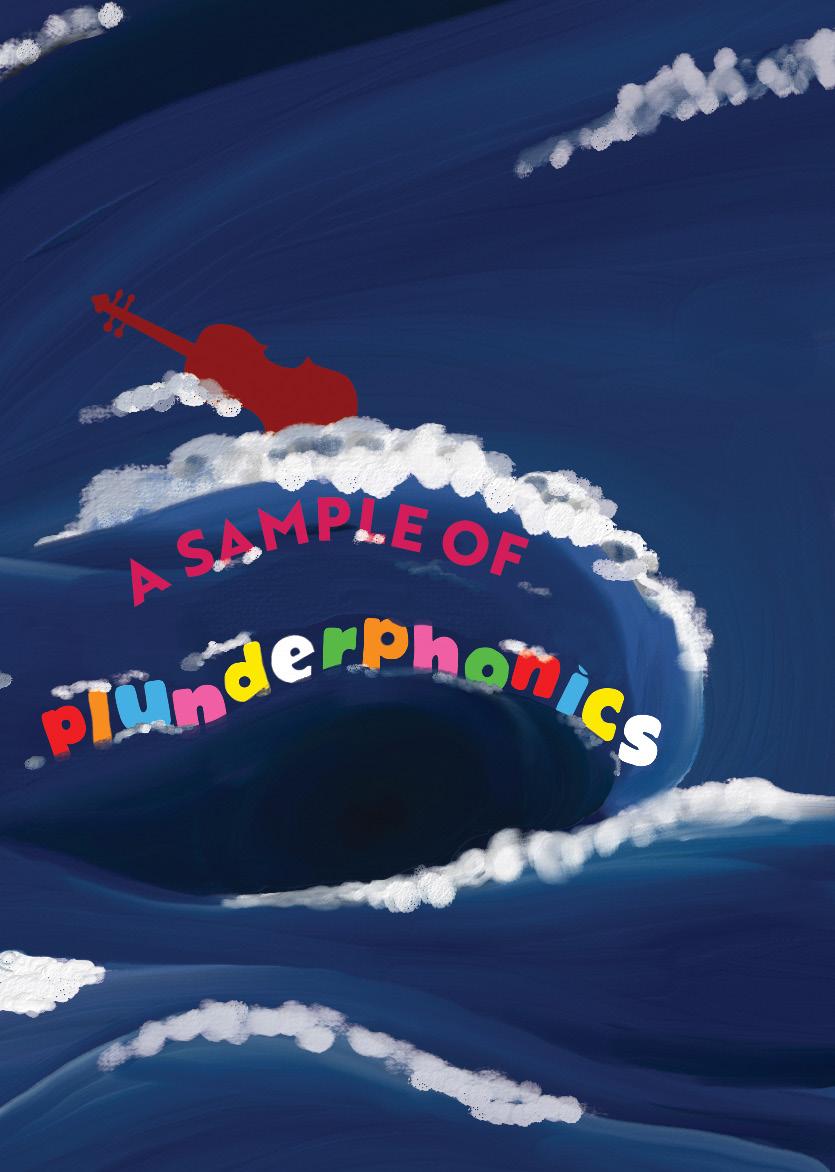
N o 52 From Groupie Freaks to Tumblr Geeks | 18 The Future Is Funky: A History of Afrofuturism in Music | 20 The Revival of Pop Music | 43 N o 76 Spring 2024 Overture for a Tortured Artist | 20 A Conversation with Stephin Merritt | 26 The Art Farmer Perplex | 34
Staff
President
Trevor Gardemal
Editor-in-Chief
Chelsea Henderson
Art Directors
Alia Ziae-Mohseni
Sydney Tomasello
Design Coordinator
Ava Ackerman Collateral Designer
Jessica Wax
Promotions Director
Emily Greenberg
Photo Directors
Julia Finocchiaro
Faith Nguyen
Vika Brennick
Features Editor
Ethan Matthews
Reviews Editors
Ananya Chaudhari
Henry Bova
Interviews Editor
Jess Gwardschaladse
Social Media Directors
Alexa Rand
Bella Ramdayal
Genevieve Kopp
Can’t



Treasurer
Michael DeVine
Staff Writers
Ahaan Chaudhuri
Ananya Chaudhari
Ana Poulin
Andrew Loose
Chelsea Henderson
Connor Bedell
Elana Lane
Emily Greenberg
Ethan Matthews
Ev Ogier
Gabriel Barbier-Saiah
Greta Radcliff
Henry Bova
Hero Williams
James Ryan
Jess Gwardschaladse
Joseph Brant
Julia Towne
Juliana George
Justin Guthrie
Katherine Miner
Kayli Harley
Keene Quiros
Kristina Saavedra
Lexa Fu
Lily-Elizabeth Zanze
Luke Colombo
Maryam Bangash
Mia Filler
Michael Earls
Olivia Leon
Peter Phelan
Rilyn Szabo
Snehaa Ram
Terrance Dumoulin
Thomas Paulus
TC Stephens
Trevor Gardemal
Wyatt DuPont
Art & Design
Adeline Yu
Alia Ziae-Mohseni
Ava Ackerman
Cami MacMillin
Edzani Kelapile
Farah Caban
Heidy Hur
Jamie Tishkoff
Jensyn Ford
Jessica Wax
Karlee Malcolm
Kristen Berzolla
Laura Mattingly
Maia Delagneau
Sarah Liu
Sydney Tomasello
Zahra Wibisana
Promotions
Alexa Rand
Bella Ramdayal
Camille McMillan
Chelsea Henderson
Chloe Liu
Emily Greenberg
Tanya Goyal
Jess Gwardshaladse
Mica Kahn
Phoebe Moore
Greta Radcliff
Tabby Randlett
Tanya Goyal
Tiffany Manulkin
Trevor Gardemal
Sofie Wendell
Sydney Tomasello
Photography
Alder Whiteford
Anna Kelly
Ashlynn Braisted
Ava DiMauro
Ava Russo
BellaJoli Gedeon
Charlotte Hysen
Coby Sugars
Darin Zullo
Edzani Kelapile
Elizabeth Scholl
Elizabeth Zhu
Emily Greenberg
Emily Kobren
Emily Zakrzewski
Faith Nguyen
Gwen Egan
Helen Cai
Jackson Goodman
Jacob Oshinsky
Julia Finocchiaro
Kelly Thomas
Krista Bernat
Krista Brochu
Maria Angelini
Max Rizzuto
Maya Solanki
Mia Rapella
Michael Nessralla
Michelle Wu
Mukki Gill
Naser Chaouki
Nicholas Alonzo
Nivedita Pai
Olivia Watson
Peter Phelan
Piper Sewell
Praagna Kashyap
Samantha Davidson
Seha Khan
Sophie Quisenberry
Taliyah Fox
Ula Bitinaitis
Vika Brennick

Tastemakers Music Magazine
232 Curry Student Center
360 Huntington Ave.
Boston, MA 02115
tastemakersmag@gmail.com
© 2024 tastemakers music magazine all rights reserved

get enough? Check out more original content on tastemakersmag.com @tastemakersmag Get More
Bryce Vine, MGM Music Hall
Photo by Kelly Thomas (Enviornmental Science)
Meet the Staff
Features Editor
Ethan Matthews is listening to...
Kelela Raven Amiture “Glory”
Kali Malone
All Life Long
Designer
Laura Mattingly is listening to...
Gang of Youths angel in realtime
Sammy Rae & the friends "Coming Home Song"
Tash Sultana "Greed"
Promotions Member
Tanya Goyal is listening to...
Panic! At The Disco A Fever You Can't Sweat Out
DPR IAN "Nerves"
Waterparks “Funeral Grey”
Photographer
Nive Pai is listening to...
Laufey Bewitched
Lorde
Melodrama
FIZZ "The Secret to Life"



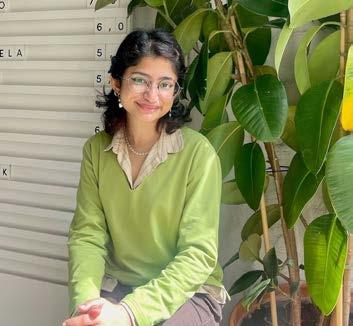
Major Architecture
Graduating Spring 2024
Favorite Venue The S outhern Cafe and Music Hall, Charlottesville, VA
Tastemaker Since Fall 2019
Quote
“A day in the life of a true Tastemakers geezer.”
Major Graphic Design & Communications
Graduating Spring 2024
Favorite Venue Roadrunner Tastemaker Since Spring 2021
Quote
“How am I the only one here born before 9/11?”
Major Business Administration and Psychology
Graduating Spring 2028
Favorite Venue The Rooftop at Pier 17, NYC
Tastemaker Since Spring 2024
Quote
“As long as everything is exactly the way I want it, I'm totally flexible.”
- Lorelai Gilmore
Major International Business
Graduating Spring 2024
Favorite Venue Thalia Hall in Chicago, IL
Tastemaker Since Fall 2023
Quote
“Huzzah!!!!”
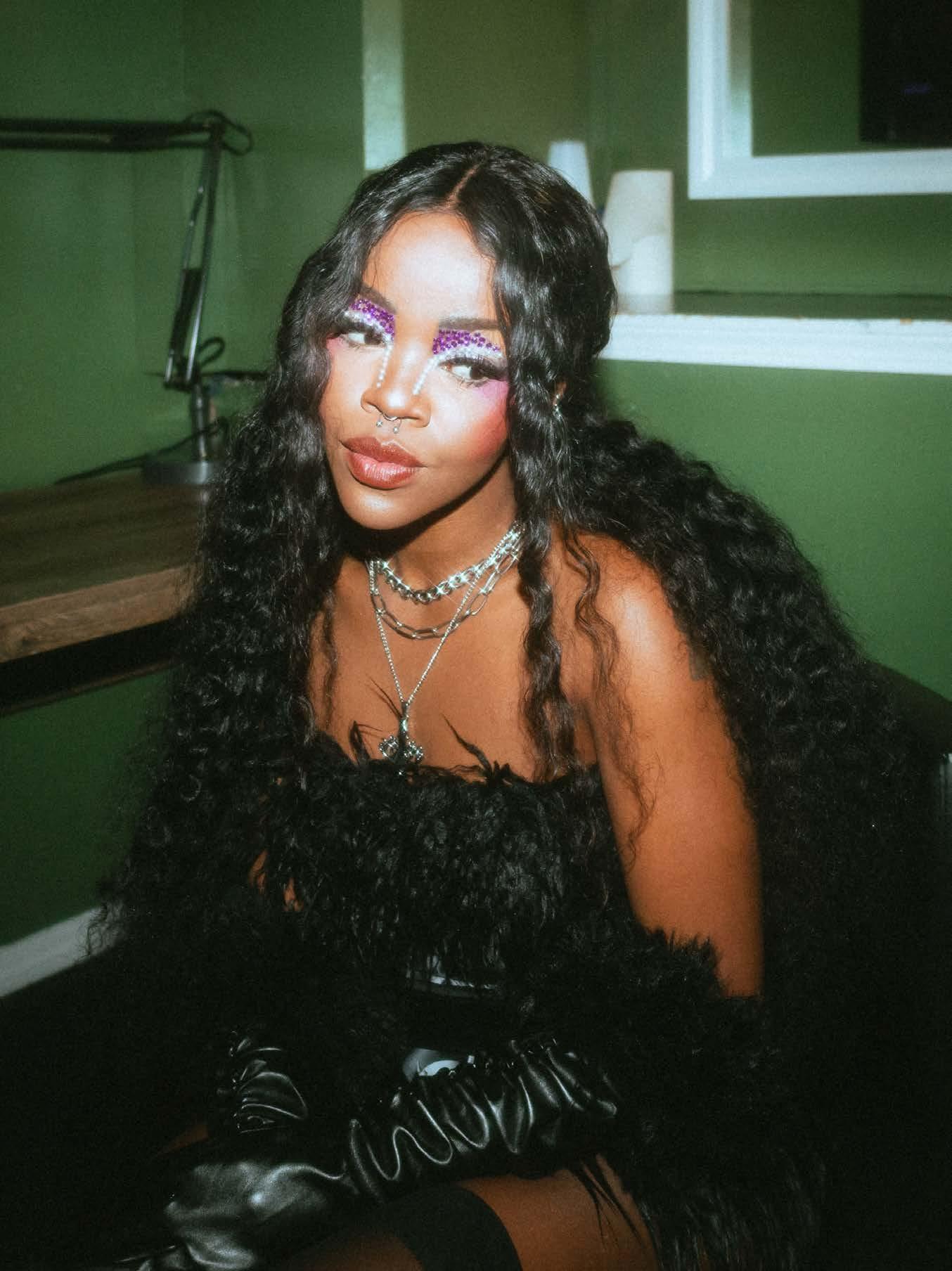 Tkay Maidza, Brighton Music Hall
Photo by Faith Nguyen (Architecture)
Tkay Maidza, Brighton Music Hall
Photo by Faith Nguyen (Architecture)
Table of Contents
Cover Story
Musical Crime or Musical Collage? A Sample of Plunderphonics
Interviews
Is music’s artistry indebted to its original writing and production, or can appropriation be just as meaningful? Plunderphonics argues for the latter. Frex Unveiled: Exploring Music, Identity, and the Creative Journey
Staff writer Snehaa Ram recently chatted with rising R&B star Frex about her ever-changing music taste, creative process, and her brunette era.
25 Years of 69 Love Songs: A Conversation with Stephin Merritt of The Magnetic Fields
Lead singer of legendary indie pop band The Magnetic Fields recently talked with Tastemakers about his songwriting, DJing, and the legacy of 69 Love Songs.
An Interview with the Winner of Tastemakers
Battle of the Bands 2024 Looking for Rocks
Hear from this year’s winner of Tastemakers’ BOTB on the origin of their name, their win, and where they’re headed next.
Editorials
Overture for a Tortured Artist
Music’s ability to capture the delusion and grandiosity of the “tortured artist” has stunned in recent years.
The Art Farmer Perplex
What should be Everhood’s rambling 96 song soundtrack is held together through ingenious compositions.
Where are the Male Pop Stars?
From Grammy wins to Billboard charts, female pop acts have taken over recently, begging the question: where have all the male pop stars gone?
Cloud Rap: The Haze of the Early Internet
While cloud rap may be out of the spotlight now, its digital footprint has shaped hip-hop and the industry in countless ways.
Soundscapes
Whether as a vessel for musical expression or a refuge from the woes of fame, drug use in the music industry is complicated.
Features
Small But Mighty: Boston’s Outsized Contribution to Alt Music
Compared to other American cities, Boston punches above its weight in its groundbreaking musical output — especially alternative.
A Second Chance at Success: Lost Music
From random TikTok audios to Panchiko, lost music is more significant to music culture than it seems. 28 14
Politics of Country
Country offers a glimpse into the duality of politics and music.
The jazz trumpeter and flugelhornist Art Farmer has one of the most complex discographies of 20th century jazz.
Etcetera
Dissects: "anthems" by Charli XCX
Learn more about “anthems,” Charli XCX’s iconic track that encapsulates the early pandemic zeitgeist.
Just a Taste of: Corinna
Take a peek inside the mind of Corinna.
In Defense of: “Divorced Dad Rock”
From Nickelback to Daughtry to Creed, maybe the now-cringeworthy “divorced dad rock” genre is overhated.
Discography: Yellow Magic Orchestra
Features editor Ethan Matthews delves into the music of Yellow Magic Orchestra — one of the most consequential and innovative artists in the history of electronic music.
Underrated: Spirit of the Beehive
The addictive complexity and darkness of psych-rock trio Spirit of the Beehive warrants closer listening.
Reviews
Album Reviews
8
Mannequin Pussy
Show Reviews
Sleater-Kinney
Cold War Kids
Tinashe
34 16 17 22 40 47
9
The Music In Everhood
and Substances: Drug Use in the Music Industry
26
20
44
24
38 48
18
32
52 12

May Calendar 2 11 24 6 13 25 7 14 26 8 18 27 9 20 30 10 22 The Decemberists Roadrunner Madison Beer MGM Music Hall at Fenway Rufus Wainwright City Winery Boston Boston Calling Harvard Athletic Complex Of Mice & Men House of Blues Norah Jones MGM Music Hall at Fenway Mannequin Pussy The Sinclair Boston Calling Harvard Athletic Complex Laufey Boch Wang Theatre Mannequin Pussy The Sinclair Boston Calling Harvard Athletic Complex Laufey Boch Wang Theatre James Arthur Roadrunner Buck Meek The Crystal Ballroom Cheekface Brighton Music Hall Holly Humberstone Paradise Rock Club Tyla Paradise Rock Club The Rolling Stones Gillette Stadium Nation of Language Royale Tim McGraw TD Garden Winkler Rockwood Music Hall Indigo De Souza Royale
Montgomery, Royale
Goodman
Science and Business Administration)
Ricky
Photo by Jackson
(Data
Justin
Justin
ROCK OMM ENDS
Buck Meek
May 7th @ The Crystal Ballroom
Big Thief's Buck Meek is performing a solo show at Somerville’s Crystal Ballroom. You won't want to miss a chance to hear the soothing sounds of his newly released folk album, Haunted Mountain.
Emily Greenberg (Communications)
Laufey
May 7 @ Boch Wang Theater
Fresh off her first Grammy win, Laufey is performing her new album
Bewitched at The Boch Wang Theatre. Come hear orchestral jazz and even see her play the cello. Watch out — you might get her mixed up with her twin sister.
Tiffany Manulkin (Graphic Design and Comms) and Chloe Liu (Graphic Design and Comms)
Holly Humberstone
May 9 @ Paradise Rock Club
Holly Humberstone writes about identity, escapism, and love by examining two contrasting sides of herself. Often singing about her bedroom both literally and figuratively, Humberstone’s intimate and vulnerable lyrics combined with captivating and haunting melodies will be an undeniably memorable experience to hear live.
Adeline Yu (Business and Design)
Flo Milli
June 1 @ MGM Music Hall
Flo Milli makes music for pretty girls who know how to have fun. Is that you? If so, you simply have to be at MGM Music Hall on June 1st. Start your summer with a concert! Flo Milli will be expecting you.
Mica Kahn (Cultural Anthropology)
June 1 16 2 20 7 21 27 8 22 28 10 23 29 15 26 30 Flo Milli MGM Music Hall Pixies & Modest Mouse Xfinity Center X Ambassadors Paradise Rock Club A Boogie Wit Da Hoodie TD Garden Melanie Martinez Beach Bunny TD Garden Origami Angel Royale PVRIS House of Blues Boston Lizzy McAlpine
Music Hall at Fenway
Webster Suffolk Downs Social House Brighton Music Hall
McAlpine
Music Hall at Fenway Feist Leader Bank Pavilion
Janet Jackson TD Garden
Samia MGM Music Hall at Fenway Allie X The Sinclair
Bailey
The Wilbur Ocean Alley Royale Boston
MGM
Faye
Lizzy
MGM
Nelly
Bleachers
Corinne
Rae
Timberlake TD Garden
Horan The Xfinity Center Bonnie Raitt MGM Music Hall
Niall
Stadium P1Harmony Wang Theatre
Zach Bryan Gillette
TD
Timberlake
Garden
Album Reviews

Mannequin Pussy
I Got Heaven
Released March 1, 2024
Label Epitaph
Genre Indie Rock / Punk
Tasty Tracks "I Got Heaven," "Loud Bank," "I Don't Know You"
The world feels foggy as bed and body separate after days of being melded together. The pillow is damp, and the first light that has hit the room in days shines on pints of ice cream and empty tissue boxes scattered across the floor. A cloud of regret forms overhead from reflections on angry paragraphs and drunk voicemails hardly intelligible through screams and sobs. This was the state of Philadelphia punk band Mannequin Pussy (MP) on their 2019 record Patience. Crushed by the world-ending weight of heartbreak, they were spontaneous, confused, and angry. Five years later they have recovered from the grief of lost love, and just as life reaches normalcy, they bump into a stranger getting off the train. As the dark, flowing hair and bergamot and citrus scent slowly fade, Mannequin Pussy realizes they have a challenge to face — confronting new love having just pieced their life back together.
On I Got Heaven, Mannequin Pussy walks alone through the vast plains of their minds. The angsty punk sound that defines them is still dominant, but their rage stems from a different place than their previous records. Healed from being wronged in the past, Mannequin Pussy reflects on their own character and place in the world. While on the surface they are content in their journey of being alone, they are one inconvenience away from setting it all ablaze. Eyes to the sky to avoid contact with others, they suppress all thoughts of future romance. Lust swirls around in their heads, and overstimulation takes hold of them manifesting as screams from lead singer Marisa Dabice and noisy, fast-paced tracks like “Of Her” and “Aching.” However, the control they exert over their introspection brings a softness that they have yet to explore.
There is a light playfulness throughout I Got Heaven that comes with the control of being alone. Highlights “Loud Bark” and “I Don’t Know You” feature it best. Lyrics “loud bark, deep bite” are repeated in a rhythmic cadence as Dabice continues with the backing of light drums and laid-back guitars. They progressively get louder and more complex, and she goes from singing to screaming along with them. “I Don’t Know You” revolves around a simple counting pattern reminiscent of a children’s nursery rhyme. It is atmospheric and rich, building a wall of sound that raises the noise level yet still feels ethereal — a release as they allow themselves to indulge in the fantasy of new love. Such extremes within each song bring out Mannequin Pussy at their most unpredictable and their most intentional. The range of I Got Heaven paces its story and highlights Mannequin Pussy as a more dynamic band with a command over the emotions that ruled over them in the past.
Mannequin Pussy is a coin spinning through the air where one side is peace, and the other is chaos. They flip through the first half of I Got Heaven before a sudden stop — caught in mid-air by desire. Completely thrown off course, Mannequin Pussy is appalled by their own temptations. How dare they catch feelings for someone new before they have found themselves? “Fuck a future” they scream on “OK? OK! OK? OK!” directed at both their future and the person they want one with. With every positive intention, the ideal lover is poised right in front of them, begging for their attention. Although they want to reciprocate more than anything, all they can ask is, “What if one day I don’t love you anymore?” Despite the waves of passion that crash on their shore, the thought of another heartbreak is unbearable and makes them more enraged.
Shocked by the unexpected remnants of their past scars, Mannequin Pussy barrels through the second half of I Got Heaven. The tracks are shorter and more aggressive, bursting with energy that was carefully balanced earlier in the record. They chase new love against the grain of self-sabotage — fighting to get back the feelings they once had while knowing they aren’t ready yet and demanding the power they had before.
The tension that builds throughout I Got Heaven culminates in the beautiful closer “Split Me Open.” Finally giving over to the “power of a thousand suns burning as one,” Mannequin Pussy realizes there is no reason to deprive themselves of pleasure over fears from the past. Infatuation, fear, excitement, unease, anticipation, jealousy, and satisfaction strike at once, overwhelming them. Dabice is calm and cheery as she vocalizes while a storm of guitars and drums pour down behind her. Alone in the eye of a hurricane, Mannequin Pussy sees with clarity they aren’t ready for love again, and as the storm clouds part, the final note rings out — a moment of bliss as they look out at the world with a newfound sense of self-assurance.
TC Stephens (Political Science and Philosophy)
7
Spring 2024 Reviews 8
Fresh
Show Reviews

Sleater-Kinney
Paradise Rock Club 3.17.24
A lot can change in 30 years, and that’s no different for SleaterKinney. Through lineup changes — most notably drummer Janet Weiss departing the band in 2019 — and a gradual shift toward a more reined-in sound, Sleater-Kinney has endured, hinging on the creative partnership between guitarists and vocalists Corin Tucker and Carrie Brownstein. Though they’re not hitting audiences with the same frenetic energy that they ravaged dive bars and clubs across the country with decades ago, Sleater-Kinney has plenty in the tank, and can still wallop audiences with their signature brash brand of punk as they have for decades.
Joined by a three-piece backing band consisting of Lou Tides and Toko Yasuda on keys and Angie Boylan on drums, Sleater-Kinney wasted no time on stage at their sold-out Paradise Rock Club gig, waking Boston up from its post-St. Patrick’s Day parade malaise. They operated as a well-oiled machine on stage, cramming 23 songs into their set and exemplifying the strength of the 30-year camaraderie between Tucker and Brownstein.
After a raucous opening set from Black Belt Eagle Scout, a queer Indigenous rock artist who informed the audience if she wasn’t opening she would be in the crowd with them, Sleater-Kinney took the stage. The band’s extensive back catalog runs 11 albums deep, but on Sunday, it was Little Rope, their grief-tinged release from this past January, that received the spotlight. Nine of the album’s 10 songs were performed, with the rest of the band’s discography sprinkled in bite-sized amounts throughout the setlist. They immediately submerged Paradise into “Hell,” the first track and lead single off of their newest album. With a red backwash and lights mimicking flames, Tucker’s lyrics about the inescapability of our hellish reality rang out, setting the stage for a high-octane, somewhat moody night. “Hunt You Down,” another highlight, saw the band go in an electronic direction, with the track’s buzzsaw synth and propulsive drumming washing over the crowd.
The band found time to weave in some old hits which helped in waking up the Sunday night crowd of aging punks. Closing out the set was “Dig Me Out,” the frantic title track off their third album that helped catapult the band into fame. Though Tucker couldn’t always match the song’s original energy, she received plenty of help from the crowd. “Modern Girl” also proved to be the biggest singalong of the night, with the entirety of Paradise joining Brownstein in the satirical hit off The Woods.
Some qualities of the band’s show will never change, most notably the pace at which they transitioned between songs. Aside from a few breaks engaging with the crowd — including wishing everyone a happy St. Patrick’s Day and Evacuation Day, and Brownstein taking a moment to shout out her dad (who was watching from the balcony) — the only other stoppages occurred for guitar changes, keeping the energy in the room at a constant high. Longtime staples of Sleater-Kinney shows, like Brownstein’s strange, staccato movements on stage as well as the piercing timbre of Tucker’s voice, delighted the crowd as well.
Unsurprisingly, Sleater-Kinney has their stage show down to a science. Through all the changes the group has endured, the band’s undeniable chemistry and liveliness shines through. Even with all the moving parts over the past few years, as long as Corin Tucker and Carrie Brownstein stick around, Sleater-Kinney will hold strong.
Henry Bova (Journalism)
9
Photo by Peter Phelan (Business Administration)
Cold War Kids
House of Blues 2.28.24

On Wednesday, Feb. 28, it was a gloomy, damp evening in Boston. But tucked inside the colorful doors of the House of Blues, vibrant energy filled the air. For the first time since 2020, Long Beach-based indie rock band Cold War Kids made a long-awaited return out east as part of their recent U.S. tour. Promoting their self-titled album — the most recent of nine studio releases — the band took COVID-19’s aftermath as an opportunity to breathe new life into their already well-established and highly successful career. The result has left their fans with even more reasons to attend their shows — and that's just what they did.
Following a fun and dynamic set from alternative singer Joe P., Cold War Kids wasted no time in commanding the crowd with the pop percussion and hard-hitting bass layering of their song "You Already Know" from 2020’s New Age Norms 2. The energy was quickly kicked into even higher gear the second the bright piano taps of "Miracle Mile" filled the air. The catchy pop ballad masks the deep yearning that underscores the lyrics of the song, filling House of Blues with an environment not unlike a coming-of-age film. The band continued their momentum, stripping back their production in some moments and returning with full gusto in others. With 20 years of music to pick from, it's no wonder the band seemed to seamlessly deliver a well-rounded, highly curated performance that ebbed and flowed like a theater performance. The band demonstrated a full range of styles, and even more notably, comfort in each one.
Led by frontman Nathan Willet's raw, emotional singing and employment of the whole length of the stage, Cold War Kids was able to connect with the audience just as well in the slow ballads as the fast-paced radio hits. Bass-slapping veteran Matt Maust flaunted his impressive skills in a more restrained way, never cracking a smile but also never missing the chance to get up close with the fans or swing his instrument around in the air. The two original members provided a great complement to each other, and it's no wonder they've enjoyed
their creative relationship together for so long. During the show, Willet himself admitted that it was an “anomaly.” Matthew Swartz, Joe Plummer, and David Quon — who have all been with the band since the mid-2010s — also provided crucial elements to Cold War Kids' signature sound, adding iconic guitar riffs, beautiful harmonies, and driving beats. Each member showcased their talent without overpowering anyone else — a characteristic surely akin to their long career of making and performing music.
Throughout the night, the five-piece rock band delivered a robust set of fresh releases, exciting renditions of their classic hits, and even some deep cuts that they’ve rarely performed live before. After 20 years of recording and touring, the band performed like a well-oiled machine, exuding the confidence that only seasoned performers can. Even after all the time, line-up changes, global pandemics, and more, Cold War Kids have provided a consistent sound and sophisticated level of storytelling in their music, honoring their long-time fans while also forging new relationships. The passion exuded from both performers and the crowd alike during melancholy songs like "Hang Me Up to Dry," We Used to Vacation," and "Hospital Beds," was deeply moving. Perhaps most striking is Cold War Kids’ ability to turn deep pain, dark stories, and overwhelming emotion into relatable and poignant art via the medium of music. Their new music was met with a warm welcome, and even after 20 years, Cold War Kids are exactly who they are meant to be.
Photo by Faith Nyguen (Architecture)
Spring 2024 Reviews 10
Faith Nyguen (Architecture)
Tinashe
The Royale 2.12.24

It’s rare that an artist achieves creative renaissance. To usher fans into a new epoch requires earnest tunnel vision — and looking back from the apex of her career, this past decade has been nothing short of a joyride for Tinashe.
In September 2023, Tinashe released her second independent album: BB/ANG3L. Her decision to go completely independent came after terminating a tumultuous, seven-year contract with RCA Records. Recently, on the Zach Sang podcast, Tinashe shone a light on outlying moments in her career, notably her collaborations with Chris Brown and R. Kelly and her mega-hit “2 On,” as being hallmarks of her label’s image for her. But, over the course of her tight set at Royale, Tinashe showed the audience what it is to witness a true performer; one that’s unconstrained by the industry and has come into their own.
Opener UNIIQU3, the self anointed “Jersey Club queen,” preceded the BB/ANG3L experience. In mere minutes, the venue's BPM surged as she frolicked about the stage, unraveling the crowd's Wednesday night inhibitions. She was determined to uplift the crowd into the new year, sealing her set with her new single, “Price Going Up,” and convincing the collective that 2024 was their year.
As the lights dimmed, a 15-minute countdown appeared on the screen — a touch that spoke for itself. Ready or not, a prompt fifteen minutes later Tinashe took the stage surrounded by five sinewy dancers, all poised to perform. Commencing with “Treason,” menacing chimes enraptured the venue. As staccato claps punctuated the anticipation, Tinashe's liquid voice rose to the surface.
The setlist wove through songs spanning her whole career, taking on its own lifeblood of highs and lows. Little time was wasted, as one song melted into the next and she skipped making pleasantries with the audience in between. Yet, this bold choice felt necessary in the context of the show — we were here to observe a spectacle, any dialogue would be superfluous.
An eagerly anticipated moment of the night, Tinashe's charttopping hit, "2 On," soared to new heights. Nestled halfway through the setlist, the electrifying energy it brought united a remarkably diverse crowd in unanimous excitement. Despite being a decade old, the track feels evergreen and represents the mid-2010’s party pop surge at its best.
Debuting in a girl group at 14 and continuing as a solo artist since the group’s disband, Tinashe has pocketed the science of stagecraft over her seventeen year career. The BB/ANG3L tour sees Tinashe exploring the theatrics of performance. She isn’t interested in the eras of it all, rather, she’s been building this glitching and glimmering world since her debut album in 2014. Tinashe has since been refining her domain within R&B, cultivating a hazy, undeniable sound that has yet to date itself. Her vision was a throughline in each element of the show, from choreography, fashion, and visuals down to the pacing.
Tinashe concluded the set with “All Hands on Deck," from her debut album. This choice closed a poetic loop, echoing the sentiment of her present moment: “Kiss the old me goodbye, she's dead and gone.” Scanning the current music landscape, originality is a scarce resource. As artists unearth new personas with each album cycle, it’s impressive to witness Tinashe’s unwavering commitment to her own vision.
Ananya Chaudhari (Business Administration/Economics)
11
Photo by Samantha Davidson (Business Administration)
Boston is better known for its Tea Party, Fenway Park, and historic North End than its thriving music scene. These attractions draw much of the tourism to the city, but it’s those who live and study here that bring it to life. Over the past half century, this city has been integral to the formation of some of the biggest names in rock and alternative music. Internationally renowned bands such as Aerosmith, Pixies, Drop Nineteens, The Lemonheads, and The Breeders trace their origins directly back to Boston. While these groups don’t share all too much in common, their early work shares important thematic ties to the city of their inception. Boston has never and likely will never achieve the artistic and cultural power of America’s metropolises, New York and Los Angeles. However, it can almost musically hold its own against massive urban centers such as Chicago and Atlanta. While this may not seem like the greatest achievement, Boston still punches
well above its weight even just by population comparison. The unique thing about Boston is that it isn’t really trying to be anything else — our small city has almost always been enough for itself.
As the 80s turned into the outright youth rebellion of the 90s, the alt rock bubble rapidly became the music that young people flocked to for comfort and emotional release. While alt rock can be said to have developed simultaneously across almost every major metro in the US and beyond during this period, Boston sheltered its own unique breed. Perhaps long, windy winters led to just a little bit of extra anger or just being surrounded by echoes of historic rebellion whips up emotions — either way, alt rock took a decidedly more DIY and punk form than cities of similar size. The Breeder’s Kim Deal was based in Boston following the temporary disbandment of the Pixies to soak up the city’s energy. Although the Breeders


Spring 2024 Feature 12
ended up settling in Ohio to record and base their music out of, it is still important to recognize Boston’s role in incubating the group’s ideas and ethos — particularly the raw garageband sound and punk themes present in early albums.
In Beantown, bands could take over a basement for a night and find like-minds in young people itching to break into the scene themselves. Differing from the myriad musical subcultures of larger urban centers, the youth of Boston fell into just a few different camps with associated social circles and lifestyles. While the argument for differences between hardcore and punk in the Boston scene could be made, the city just wasn’t big enough in the 90s to create a sense of specific geographic place; instead, kids who in other cities had defined territories ended up skating and partying in a lot of the same spots. This sense of uneasy comradery was essential to the growth of the scene and was clearly paralleled in more mainstream alternative circles. Even today, a house show might have indie pop and middleof-the-road alternative rock in a lineup for the night.
Drop Nineteens, a band that held up the shoegaze mantle in Boston better than nearly any other city in the US, was a shining example of how close physical proximity between scenes could create something greater. While shoegaze was a classification almost exclusively falling to groups coming from the U.K., the band proved that Americans were just as capable of breaking into the subgenre as Brits. Their debut album Delaware featured their original lineup and had far more staying power. Even today, a foray into the subgenre would not be complete without listening to “Kick the Tragedy” and “Winona.” The group ultimately found more popularity in Europe than the US, but key actions such as the recording Delaware in Boston’s iconic Cyclorama building cemented their early years in our city — the same building that the Pixies recorded Doolittle in. By starting out in Boston, their work was imbued with cross-scene influences that might never have reached them in larger cities.

within the city limits. Tastemakers' own Battle of the Bands is a great example of this phenomenon — groups just starting out are given a platform to try out performance styles, get over stage fright, and engage with a particularly friendly audience. In a college town, bands can grow with the audience rather than having to meet fans in the middle; and besides, everyone loves being able to say that they went to a now famous band’s first show. In the age of the internet, some local artists have had a meteoric rise to fame largely through an online presence — we’re looking at you, Clairo — but many bands can still be discovered here through the iconic basement show. Even in the age of streaming, fans flock to the dank cellars of Boston’s triple deckers to hear the first gasps of what could be the next big act in the alt or indie scene. Streaming largely picks up after the show, acting as a uniquely modern way to break out of the local scene and into the world at large.
While our city can’t lay claim to pop icons the same way that New York or Los Angeles can, it has certainly secured its spot as an integral part of music history. More importantly, we should take stock of the unique factors that make Boston an incubator for incredible talent and try to safeguard it for the future. University-led initiatives and programs to develop or encourage local talent — this magazine being one of them — make sense as a method to highlight emerging voices and build fan bases. An endless supply of college students and 20-something transplants itching to get out of their apartments will always have interest in listening, but there must be easily accessible space for artists to play. Equally important are the choices made outside of institutions. The next basement show you go to in Allston could end up being an “I was a fan before they got big!” story a decade from now. Starting small and obscure is exactly the formula that Boston relies on for its music scene, and that’s why it has always — and hopefully always will be — home to a scene far more successful than the sum of its parts.
Boston’s small scale inadvertently acts more as a musical incubator than other cities in the US, taking some of the pressure to succeed right away off fledgling bands. Instead, artists have years to develop their sound through underground shows or gigs at one of the many universities
• Terrance Dumoulin (Civil Engineering & Architectural Studies)


13
Designer: Zahra Wibisana (Computer Science and Design)
Exploring Music, Identity, and the Creative Journey with

Instantly recognizable for her bright orange hair, Frex is a musician on the rise. Skilfully blending R&B with her vibrant personality, fans are anticipating a new project after the release of several successful singles.
Tastemakers sat down with Frex to talk about her ever-changing music taste, her plans to showcase her love for R&B and alt-pop in upcoming projects, and life as a part of a major label. From studio sessions to social media, she offers insight into her creative process as well as how she cleverly navigates her career.
This interview has been edited for brevity and clarity.
Tastemakers Magazine (TMM): Where does the stage name Frex come from?
Frex: Frex comes from freckles. I have a lot of freckles. They’re not as clear on my face anymore because I started wearing sunscreen.
TMM: I’m assuming that’s why your Instagram username is @youngfreckle.
Frex: When I made it, it was a joke, like how Drake has @ champagnepapi and Rihanna has @badgirlriri. I just thought @ youngfreckle was funny, and it was a clean username.
TMM: I’d love to know a bit about your music taste. What’s been in your rotation recently?
Frex: I’d say I’ve been listening to a lot of MGMT, Empire of the Sun, PARTYNEXTDOOR, and surprisingly, Kid Laroi. Never really listened to him before. I’ve been revisiting a lot of alt music that I used to listen to. I think that will probably influence my music coming up.
TMM: What resonates with you the most? Do you feel like the music you listen to helps guide your own process?
Frex: I’ve been trying to take little bits and pieces from whatever
speaks to me. Before signing to a major label, I always felt like if I was going to have a “big song” that I would much rather do an alt song. I like R&B, but I’m not like the big R&B girls...I don’t have the powerhouse vocals. I’m not going to be the next Summer Walker. But being signed to a major label, there’s pressure there to have a song that has a bigger feel to it. I can see myself making alt-pop because that’s what I enjoyed growing up: Foster The People, Young the Giant, Two Door Cinema Club.
TMM: That’s so interesting, because with your album, Blu, and some of your other singles, there’s definitely going to be a tone shift from R&B to alternative music.
Frex: It’s funny that you say that because I didn’t know what I was going to do there for a second. I didn’t know if I was full R&B or alternative R&B. My music will always be inspired by R&B, but will also have that alt-experimental sound to it.
TMM: Walk me through a studio session with you. What is that like?
Frex:I like to make songs from scratch, I’m just so particular about being a part of the song and putting what I feel into it. I’ll go to the studio and I’ll show them a couple songs I like, and then we’ll start to play a couple chords and experiment with some drums. Recently, I’ve been more inspired and I’ll lay a synth line down. And then while the producers are working, I’ll sit there writing. Hopefully by the end of the session I can lay down some vocals.
TMM: Have you had the chance to learn about production? Didn’t you teach yourself how to play the guitar?
Frex: When I first started making music I was making my own beats. I started on GarageBand, then Logic, and then SoundCloud, where I felt like everything sounded a lot better. Then I met a longtime collaborator of mine – Godchild, who did all of Blu – and took a backseat on production because I was more concerned with songwriting. A couple years ago, I picked up the guitar again. I played
Spring 2024 Interview 14
Designer: Ava Ackerman (Marketing and Design)
when I was younger— self-taught, nothing crazy — and practiced chords over and over again. Those actually ended up being the chords for “Oxford Circus.”
TMM: At the end of your creative process, how do you know you’re done with a song? Are there certain qualities you’re looking for when you listen to it? Or would you say it’s a gut feeling?
Frex: Usually what will happen is I record the lead vocal, get that right, and then move on to the backgrounds. I might think it needs some more work, butI take a few days before I listen to it again. Sometimes I think, “Okay this didn’t actually need that. Take it out.” You eventually have to stop trying to overwork a song. I feel that I’ve done all I can do when I try to add more to a song, but it doesn’t make it any better. That’s when I decide it’s done.
TMM: Your lyrics tug at the heartstrings of longing, learning to trust people, and making sense of both love and heartbreak. What draws you to talking about these themes?
Frex: They have been common themes in my life. My parents didn’t have the best relationship, so I’m always trying to figure out what’s normal. It can be tough when you didn’t have that model for you. I use music as an escape and if I write about what I am feeling, it makes me feel better.

TMM: Do you have a favorite song you’ve made thus far?
Frex: I really like “Oxford Circus,” “Postcards,” and from Blu, “Luv That Destroys Me.” It was such an early song but I love that beat. My songwriting skills were not there yet, but I just think that was such a cool song.
TMM: On TikTok, you had posted something about changing your hair color. First of all, the brunette looks amazing. How would you say your iconic orange hair has played into your aesthetic? Do you feel like brunette hair is a new era for you?
Frex: Well first, I have an appointment to go back to ginger tomorrow. I thought I would like being brunette more but I just don’t. I dyed my hair orange in 2019 and as soon as I did, people on the LA scene started taking me more seriously and started remembering me. I knew that it was a hack for increasing engagement. I also went to Catholic school my whole life and wasn’t allowed to dye my hair any crazy colors. I guess this was an act of rebellion.
TMM: We are still in the early stages of 2024. What’s next for you?
Frex: It’s always changing because I’m insane… I can’t tell you how many projects I’ve made and scrapped. As it is right now, I think I’ll have an EP coming out relatively soon. The next stuff will be bigger!
• Snehaa Ram (Business Administration and Communication Studies)

15
Charli XCX’s song “anthems” was written and recorded in the early months of 2020 as the penultimate track for her fourth studio album, how i’m feeling now. Written about the pandemic from the perspective of a popstar and party girl, how i’m feeling now manages to balance themes of loneliness and uncertainty with Charli XCX’s larger-than-life persona. Released at a time when live music and clubs were closed indefinitely, the album rebels against the mundanity of life in lockdown with experimental dance pop and racing synth beats. “anthems” is one of the most intense tracks on how i’m feeling now, and its lyrics reflect on the ennui of its time while looking toward a brighter future.
In 2020, celebrities were put under a microscope for the way that they discussed their experiences during the pandemic — and for good reason. When people who are known for their wealth and success made public complaints of isolation or hopelessness, it did not exactly strike the chord of solidarity with the general public that celebrities hoped to achieve. Think Gal Gadot’s infamous “Imagine” video, in which she was joined by other A-listers in a cover of the John Lennon song. Not only was it incredibly cringeworthy, but also tone-deaf, as millionaires in their luxury mansions were not faced with the same hardships as the working-class. Music created by mainstream artists during the pandemic were at high risk of falling into the same pitfalls of out-of-touch unrelatability. But Charli XCX, who wrote and released her album how i’m feeling now in May 2020, successfully executed a “we’re all in this together” narrative without becoming a clichè. With “anthems,” Charli XCX taps into universal feelings of loneliness during the pandemic in a way that is both true to herself and relatable to her audience.
Songs like “anthems” succeed in evading the insensitive nature of other celebrities because Charli XCX does not try to be something that she is not. She does not step down from her pedestal of a beloved pop star; if anything, she embraces it. In its chorus, she laments over how much she misses clubbing and partying: “I want anthems / late nights, my friends, New York.” The pre-pandemic life that Charli yearns for is not one that we all have — she is longing for travel, exclusive clubs, staying out all night to party. Sure, there is a superficiality to this in its own right, but that is the point. Charli XCX isn’t a working class woman — she’s a pop star, and her lyrics reflect

her own life. She’s not pretending to have it as bad as everyone else in the world, but speaking directly to her own experiences.
Charli counters the party-girl lifestyle that she misses with the verses in “anthems,” which break down the mundane nature of her day-to-day life. The song’s first words are “I’m so bored / wake up late and eat some cereal / try my best to be physical.” The juxtaposition of these plainly written lyrics with the chorus highlight the freedom and youthful recklessness that Charli XCX has been forced to give up — feelings that any twenty-something-year-old who lived through the pandemic can relate to. Because she speaks so frankly about herself and what she misses, Charli sounds more earnest when her chorus ends with “finally when it’s over / we might be even closer.”
The most successful aspect of “anthems,” and arguably the most successful part of how i’m feeling now as a whole, is its innovative and experimental production. Produced by Danny L. Harle and 100 gecs member Dylan Brady, anthems is driven by a raucous, high-energy synth chord progression. It is immediately attention-grabbing and infused with the energy of the late nights at the club that Charli misses so much. Its instrumentals make it so you don’t only understand what Charli is saying, but feel it as well.
Artists and labels like PC Music had been creating autotuneinfused, high-energy electronic pop music for years, but these musicians remained under the mainstream radar. Charli XCX helped to bring this subgenre to the forefront of pop music through frequent collaborations with producers like SOPHIE and PC Music founder A.G. Cook. Around the same time in 2020, Brady’s band 100 gecs gained traction in online spaces. For better or for worse, producers of experimental electronic pop were lumped together in the genre of “hyperpop.” Charli XCX herself seemed surprised to be assigned a new genre, tweeting “what is hyperpop?” in July 2020.
In a time during which the future of music was uncertain, Charli XCX delivered a new sound to pop music. Alongside her collaborators, she created an album that brought “hyperpop” to the forefront, and spoke honestly about her struggles during the pandemic. “anthems” is the perfect encapsulation of what how i’m feeling now does best, and three years later, stands as a testament to its time.
• Jess Gwardschaladse (History, Culture, and Law)
Designer: Farah Caban ( Business and Design )
) : Spring 2024
16
Photo Credit: Lauren Scornavacca ( Industrial Engineering
Etcetera


17
• Emily Greenberg (Communications)
MUSIC A SECOND CHANCE AT SUCCESS: Designer:
LOST

(Computer Science and Design) Spring 2024 Feature 18
Alia Ziae-Mohseni
In music, it’s not often that artists and their art are given a second chance for success. It’s an unfortunate truth of the industry that first impressions can be everything. Some artists spend their whole lives creating art that the world may never hear. Though the global nature of the Internet and accessibility of the online streaming world has increased music sharing, there are still millions of unheard songs. On Spotify alone, it was found that around 45.6 million songs had zero streams in 2023. And that’s only on one digital platform; there’s no telling how many unheard songs are hiding throughout the many caverns of the internet. When you add in the myriad of unpublished cassette and CD demos, the amount of lost songs becomes astronomical. By this logic, how is an independent artist ever meant to compete? A song they pour their heart into has a higher likelihood of ending up lost to the sands of time than heard by even one other person. But what happens when a piece of music is given a second chance?
A little over two months ago, an audio began to circulate on TikTok. Normally accompanied by an image of a Y2K pink boombox, the audio is only seventeen seconds long and the sonic quality is poor. Many users noted in the comments that they’d heard the song before but couldn't recall from where. The clip consists of a punchy baseline, a vintage synth, and vocals. While the lyrical content remains up for debate to this day, the song itself hails from the 1980s. Seemingly overnight, a community formed, attempting to find the origin of the audio. But what TikTok wasn’t aware of is that the hunt for this earworm has been in full swing for the last three years.
“I was the second member ever in the sub, after the creator,” said Reddit moderator u/Sodapopyarn. “Many people have joined the search following sombertoboggly's video featuring blameitonjorge about the subject[song].”
The subreddit r/everyoneknowsthat has amassed around 33,900 users since its creation in July 2023. While the subreddit was officially created less than a year ago, the song, informally titled “Everyone Knows That,” has been in circulation within the lost media community since 2021. The mystery began on a website called “WatZatSong,” when user Carl92 posted the clip.
“I rediscovered this sample between a bunch of very old files in a DVD backup. Probably I was simply learning how to capture audio and this was a leftover,” he posted. He went on to state that the clip was most likely recorded when he was living in Spain, but refused to go into further detail. Then, for seemingly no reason, Carl92 disappeared. WatZatSong was flooded with new users attempting to message Carl. In January of this year, the website became aware of the search and contacted the owner of the account, but haven’t heard back. This is one of the main reasons some lost media enthusiasts believe that the song may be a hoax.
Despite the naysayers, the community continues to grow. Leads have been few and far between, as it’s hypothesized that the song does not exist on the internet. One major lead has come from analyzing the frequencies of the recording. The analysis revealed that the clip contained a signal/noise ratio of 15734 Hz, which is characteristic of analog television broadcasting. This specific
frequency is the horizontal scan rate noise of the NTSC broadcast, which is only used in North America. This has narrowed down the search significantly. Participants have taken to contacting major radio and television broadcasters throughout North America in hopes that the song is somewhere in an archive. Due to the horizontal scan rate noise, many suspect that the song was recorded off of a TV and comes from a commercial or television show.
Many have deemed the song a lost cause as the prospect of having to physically search (off the internet) seems impossible. “We live in a world where we think anything is accessible and on the internet. If it doesn’t exist there it doesn’t exist. And that’s just not true,” u/ Twinseylohan, another moderator of the subreddit, shared.
In January 2020, another famous lost music media search came to an end; the mysterious “D>E>A>T>H>M>E>T>A>L” CD by Panchiko that was found in an Oxfam charity shop was finally solved when u/LindyKamek and another search party member found one of the band members on Facebook. Much like “Everyone Knows That,” the album had zero online history. But, they analyzed the barcode on the album cover and found the exact Oxfam location. From there, they were able to search the small UK town for any of the four first names that were listed on the back of the album. Finding an “Owain” in the area, they messaged him, and the mystery was solved.
“It really was an interesting feeling when it was found since so many cases remain unresolved. I suppose we got lucky since there was enough information to get us to the finish line,” said u/ LinyKamek, reflecting on their involvement in the search. Since the discovery, Panchiko has gotten back together, released more music, and is currently on tour.
To some, the concept of lost music may seem insignificant. If a song is “important,” it’d be famous. After all, a song's value lies purely in its message and content, right? “I personally believe that all works deserve to be archived and recognized to give the artist(s) the great credit they deserve…I'd really just like to add how grateful I am to have a community so passionate and determined,” expressed u/ Sodapopyarn.
“I learned all I could and became close with everybody… My role is just to support my fellow mods, ensure sub quality and create community,” u/Twinseyloahn added.
If you delve more and more into the r/EveryoneKnowsThat subreddit, sentiments similar to these continue to pop up. It’s clear there’s a strong sense of community and trust there. People from all walks of life have been able to bond over their shared interest in finding this song. And is that not the goal of music? To express and connect with others? Musicians make music to be heard. And to be heard is to be respected and cared for. Regardless of if “Everyone Knows That,” is found, or whatever the original intention of the song was, it’s been the mystery surrounding it that has changed people’s lives. Any song that can achieve that deserves a second chance to be heard among the noise.
• Ana Poulin (Music Technology)
19

Spring 2024 Editorial
most serene, domestic moments easily become some of its most intense. Only in “May December” can the line “I don’t think we have enough hot dogs” send a pit to the audience’s stomach, aided by the spectacle the score creates. The score is designed to take the viewer out of the film and pressure them to sit with the grotesque and contradictory characters with a renewed sense of reality. As the film progresses, the viewer begins to anticipate the next thrum of a dark, rich chord, but is left on their toes as Zarvos leans into the delicacy that the emotional world of the film’s characters require, keeping the audience firmly in the role of “spectator.” The film’s viewers are forced to make judgments and participate in the delusions of Gracie, and eventually Elizabeth, by the omnipresence of the score.
Phantom Thread (2017)
Jonny Greenwood’s lush and tender score for “Phantom Thread” subtly builds tension and emotional drama as the audience realizes how harmful the dynamic between Reynolds, the well-established fashion designer, and Alma, his lover and muse, really is. Greenwood, Radiohead guitarist turned film composer, was inspired by the dense orchestration of love ballads of the 50s and 60s, recording the score with a full 60-piece orchestra. The film, and its score, operates in the cross section between erie and alluring, exploring the ways that beauty and aesthetics can mask darker truths. The sheer devotion, controlling nature, and passion of Reynolds comes through in the score’s intense swells of string instruments. Neurotic and deceptively charming, this score plays up the main character’s knack for aesthetics and appreciation of beauty.

between the image the film’s characters wish to present and the way they truthfully feel about themselves. These moments contrast sharply with the loud, heavy sounds of rehearsal scenes with the full band as performed in the film. Instead of leaning into the bombasity of jazz, Hurwitz and Simonec build these tracks one note at a time, using the textures of a jazz band in a new way, creating a result that feels like earthly electronic music.
Tár (2021)
Hildur Guðnadóttir set out to capture “the messiness of the work involved in preparing classical music for performance” in the score for “Tár.” Posed with the unique challenge of needing to literally embody the film’s titular character, Guðnadóttir created the fictional music that highly-acclaimed composer Lydia Tár is working on in the film. In this metastructure, Guðnadóttir repurposes Mahler’s Fifth Symphony as performed and conducted live by Cate Blanchett and the Dresden Philharmonic. Juxtaposed with Guðnadóttir’s sparse non-traditional compositions, these rehearsal scenes are particularly memorable. The film’s score and narrative both relies on Mahler’s work for a heightened sense of credibility and tradition while leaning into the titular character’s wandering, corrupt nature in its original compositions. At points in the film, the score is almost undetectable, drawing the audience’s attention to the sheer magnitude of the Mahler’s Fifth in roaring rehearsal and performance scenes. “It’s like having a ghost in the room that you can’t see, but you can feel” said Guðnadóttir of her unconventional score. “For Petra” is delicate and fleeting, unlike basically everything else in the film, while the very stern “Tár” three-part composition reveals the titular character’s mastery of tension and discomfort. Guðnadóttir includes Tár speaking German to her orchestra in recordings of rehearsal scenes to weaponize the exclusivity of classical music and displace the audience. We are left out of the action just as we are finally able to hear what Lydia has been preparing, forced to sit back and let the experts work in private. These moments are a reminder of how Lydia sees herself and the world of classical music: an elite club, to which the entry fee is blood, sweat, tears, and the right connections.
• Joseph Brant (Political Science & Economics)

In Defense OfDivorced Dad Rock
With the opening lines of their song “Photograph” “Look at this photograph / Every time I do, it makes me laugh” Nickelback may have written some of the most notoriously mocked lyrics of the past two decades. And they are not the only ones. Daughtry, 3 Doors Down, Creed, and Stain’d are just a few of the bands that are branded alongside Nickelback as “divorced dad rock,” shunned for being “inartistic” and “not real rock.”
To be fair, there is merit to some of these claims. These bands have released albums that are repetitive and even uncreative. Sorting through their discographies, you won’t find too much variety or instances of these bands pushing themselves out of their lanes into new possibilities. Even so, social media shows a resurgence of support for “divorce dad rock” with people making videos admitting to secretly enjoying the genre. Perhaps the lasting influence of bands like Nickelback and Daughtry is not their artistic impact, but rather their nostalgic sound and their ability to provide audiences with enduring satisfaction. If listeners keep coming back, there must be something worth coming back to.
Despite constant ridicule from the public, Spotify streams for these bands remain high. As of March 2024, Nickelback has 17.2 million monthly listeners. While the general public might know them for “Photograph,” the song isn’t even in the top five of the band’s most listened-to tracks.
“How You Remind Me” — a song of brutal self-reflection, backed by lead singer Chad Kroeger’s confident rasp — stands at the top of the list with nearly 930 million streams. At 12.4 million monthly listeners, 3 Doors Down keeps a steady fanbase, and Daughtry’s 3.8 million still garnered 184 million streams for
their number one track “Over You.” These are not record-breaking numbers, but they reflect how many people seek out these bands and enjoy their sound.
In terms of lyricism, the storylines these bands create have more to offer than seemingly shallow and unoriginal words. If one can keep from cringing during the start of “Photograph,” the storyline turns into one of reminiscence and grief for childhood memories. The opening lines establish the song’s bittersweet tone. Kroeger walks the listener through his hometown, singing to them as though they share the same memories while he notes how things have changed. The last lines of the chorus, “It’s hard to say it, time to say it / Goodbye, goodbye,” convey a reluctance to let go but an acceptance of the inevitability of change. The lyrics may not be complex, but they deliver a straightforward message listeners can relate to if they lean in and get to the root of the story.
Daughtry ’s “No Surprise” has similar lyrical depth, detailing the experience of a couple who no longer has a reason to stay together. The song has the expansive element of pop while maintaining an edgy quality with its solid drum track and confident lead guitar riff. The energetic building of the bridge and outro convey the duality of the couple’s feelings as they try to let go. It’s an expression of exasperation as well as a release of frustration. Even years later, this song hits home for listeners.
Despite falling short compared to other modern rock, these songs demonstrate how we can enjoy bands for what they do well and forgive them for what they do poorly. Sadly, mob mentality now makes casual enjoyment of these bands difficult. When people hate for the sake of hating without formulating their
own opinions, others are forced to feel guilt and shame for what they like. So was the case with Nickelback. Mention them to a stranger and chances are they will visibly cringe — it’s automatic. It’s visceral. If you listen to a comprehensive list of their songs and walk away still disliking them, that’s entirely justifiable. But if you’ve only ever heard the opening lines of “Photograph” and proceed to describe how Nickelback is a disgrace to rock, that’s regurgitation.
“Divorced Dad Rock” exists as a label for a reason, and it’s valid for people to critique the style, but a band can lack the qualities that would elevate them to legendary status and still be enjoyable. After all, the root of music is celebration. You don’t have to buy their T-shirts or hang their posters on your wall. Just lend these bands your ears for a few minutes. When we pick apart the songs we may otherwise judge and really listen to them, we might just find something worth appreciating.
• Kayli Harley (Communication Studies)



Spring 2024
22
Designer: Edzani Kelapile (Media Arts)
Etcetera
 Jack & Jack, Brighton Music Hall
Photo by Anna Kelly (Health Science)
Jack & Jack, Brighton Music Hall
Photo by Anna Kelly (Health Science)
From Johnny Cash to Morgan Wallen, some visual and sonic totems like blue jeans, liquor, and guitars have been consistent in the history of country music. These symbols have been used by different artists across the genre’s history, telling stories of heartbreak, triumph, and Americana. These representations have also historically been used to promote conservative political causes, and they continue to do so when used by modern country artists. This has become clear as country experiences a new golden era — one that, according to Billboard, saw an increase in listening by 20.3% in the first six weeks of 2023. Four of the #1 Billboard Top 100 hits of 2023 were country music songs, with the songs varying in their levels of political messaging. Looking at the history of these artists’ politics, and the history of the cause they are supporting, provides
information on how causes are cultivated for an artists own gain, and why some political messages are chosen over others.
Morgan Wallen had the biggest undeniable country hit in 2023, with his song “Last Night” living at #1 on the Hot 100 Chart for 16 weeks. The song is apolitical in nature, using many of the emblems expected from a country hit to recount the feeling after a night of heavy drinking and the accompanying fear of having ruined a relationship. The song’s avoidance of politics may be surprising to those who know of Wallen’s past controversies and social stances. In October 2020, Wallen’s scheduled “Saturday Night Live” appearance was canceled after refusing to comply with the show’s Covid protocols. This would only be the start of controversy for Wallen, who then faced backlash in February 2021 after a video of the singer drunkenly using a racial slur went viral online. In the days after the video’s release, Wallen’s music was pulled from SiriusXM and iHeartRadio stations, his contract with Big Loud Records was suspended indefinitely, and he was dropped from streamers’ featured playlists. Wallen apologized for the incident in a video posted to Instagram, where he asked fans not to defend him, instead saying: “It’s on me to take ownership for this, and I fully accept any penalties I’m facing.”
Despite the backlash, commercial penalties were relatively minimal, with the

controversy’s exposure seemingly boosting Wallen’s popularity. Wallen’s total sales across albums and songs jumped from 5,100 to 35,200, according to MRC Data, and his album Dangerous: The Double Album remained at the top of the Billboard album chart for seven weeks. The strength in these numbers came from conservative fans feeling Wallen didn’t deserve to be punished for his actions, showing their support by buying and streaming his music. Resting on this audience, but wary of teasing another cancellation, Wallen pivoted to an apolitical persona in his public actions and songwriting. Out of this came “Last Night”: his biggest hit so far.
Wallen is an example of an emerging country artist refuting politics for the sake of their image, but what about country artists whose best days are behind them? How do they use the tools of the genre to reclaim some of their fame while drawing wide enough attention to also gain new fans? Jason Aldean was an artist struggling with such questions, and his answer came in the 2023 Billboard Top 100 #1 hit track, “Try That In A Small Town.” Before the single, Aldean never had a #1 hit. His best performing song, 2007’s “Dirt Road Anthem,” merely peaked at #7. “Try That In A Small Town,” which is a belated response to the social upheaval following the murder of George Floyd, positioned Black Lives Matter protests
Fall 2020 Editorial 24
) Spring 2024 Editorial 24
Designer: Karlee Malcolm ( Design
against small town Americans in an “us versus them” narrative. The song’s music video saw Aldean performing in front of a courthouse that is infamous for being the location of the lynching of a Black teenager in 1927, while equating rioters and BLM protestors through news clips in the video. The song, and its corresponding music video, garnered exactly the controversy Aldean was looking for.
Outrage came from the political left, who saw the song and the content of the video as offensive, leading CMT to pull it from the air and Aldean’s team to edit out footage of protestors. There were questions of what authority or purpose Aldean had in releasing such a song, seeing as it came out years after the focus of the song had happened and Aldean’s primary residence in Nashville can hardly be considered asmall town. Aldean released the song because of the attention, positive or negative, it would inevitably give him. Wallen proved that a country star can avoid liberal “cancellation” if they appeal enough to conservative country fans, and so those are the fans Aldean chose to target. He did this while playing into the normal tropes of country music, making it appealing to a wide country audience, and giving Aldean the first #1 of his career, building himself a comeback on controversy.
To say political country music only comes from an inauthentic place would be ignoring the genre’s history as one for the

common people, making stars out of poor white Americans singing of their troubles. Oliver Anthony continues this part of country’s legacy with his song “Rich Men North of Richmond,” taking aim at politicians who feed off their constituents. The song’s earnestness comes from Anthony, who hails from rural Virginia and has a history of factory work. Anthony’s disinterest in political parties was highlighted when the song rose to popularity after it was used at a Republican primary debate last August, which Anthony found to be ironic, saying that the song was “about those people.” Anthony uses country as an advocate for his causes because of his belief in them, not for ulterior motives like Aldean. He gained popularity because of how people responded to his message, regardless of if it was the type of person he was trying to make an impression on or not.
There are, of course, examples of apolitical country artists and songwriting, such as Zach Bryan’s #1 Billboard Hot 100 hit “I Remember Everything,” featuring Kacey Musgraves. With acoustic guitar carrying melodious lyrics of whiskey easing the mind and summer heat, “I Remember Everything” uses the hallmarks of country without attempting to make any political statement. This mirrors how Bryan has gone
about addressing his politics, refusing to show direct support for either political party. Musgraves, who features on the song, has been vocal about her liberal politics in the past, and even received a GLAAD Vanguard award in 2022 for her allyship to the LGBTQ+ community, yet these politics aren’t present in this song, or any of her songs, for that matter. Both Bryan and Musgraves represent artists making their music apolitical to reach a general country audience — one that mixes party lines.
Politics are used in every genre, but the strength of the country audience allows those messages to be amplified to a greater degree than many other genres. It is important then to consider when and how artists choose to use their political voice, and from what place those messages originate. That way, it will be easier to decipher who has a message they feel is worth sharing, and who’s just another Jason Aldean.
• James Ryan (Communications and Media Studies)
25


Stephin Merritt can’t find his suitcase. It’s not in the closet next to the wall of tens of thousands of CDs in his hallway, and his two chihuahuas are confused by his frantic search. They don’t know that he’s about to leave for The Magnetic Fields’ 25th anniversary tour for their seminal album 69 Love Songs. Over three discs and a shocking amount of musical styles, The Magnetic Fields meditate on — and often lament — the subject of love. This month, they’ll be embarking on a tour across the United States and Europe. The tour kicks off in Boston, and at each stop they’ll perform the album in its entirety over two nights. erritt prepared to depart, Tastemakers spoke with him over the phone about the last 25 years, inspiration, and difficulty writing new music.
This interview has been edited for brevity and
Tastemakers Magazine (TMM): I read that you don’t necessarily feel excitement toward touring. Is this something that you’re
Stephin Merritt (SM): I dread touring, but, in this case, I’m really going to be happy to be in a colder air; I love the cold. I hate the heat, and it’s unseasonably warm in New York. It’s going down to 18 degrees.
TMM: I also saw that you said that you change “The Book of Love” pretty frequently when you are performing it. Is that an intentional decision?
SM: Well, we change it because we don’t want to become bored, and we’ve played it at almost every show for the last 25 years. We don’t change it like Bob Dylan, we change more on the instrumentation. But I don’t sing “The Book of Love” to the tune of “Fido Your Leash is Too Long,” or anything like that.
TMM: How do you think you have changed in the last 25 years?
SM: Well, I’m older and sicklier and weaker and more cranky than ever. A little nicer. I don’t know. You’d have to ask my friends instead of me. My friend and dog walker says crotchety, cantankerous. I was more like that 25 years ago, actually. I think 25 years ago I did not suffer fools gladly and now I’m resigned.
TMM: Right. Speaking of sicklier, I understand that you’ve been having trouble with songwriting since you got Covid four years ago.
SM: I’ve been having trouble finishing songs. I am still writing all the time, just not finishing. And finishing a song is kind of by far the least important part of the song. The most important part is thinking of the song idea, and I’ve been doing a lot of that. I also have at least hundreds of songs in notebooks. So never fear. I probably shouldn’t have ever said
Designer: Cami MacMillin (Communications and Graphic & Information Design)
Interview 26
Photo by Marcelo Krasilcic
Spring 2024
A Conversation with Stephin Merritt of The Magnetic Fields

anything about that because no one would notice if I never wrote a song again.
TMM: In terms of ideas, have there been any themes that have been sticking with you lately or —
SM: No I don’t talk about that.
TMM: Okay. Got it.
SM: I never talk about unreleased songs.
TMM: I know that you’ve been DJing for an event called “Fuzzy.” How does that compare to playing live?
SM: It’s not similar. DJing, you get to go to the bathroom whenever you feel like it. I don’t see any comparison. It’s like "what’s the difference between a dog and a parking garage?" They’re not similar, other than they’re both musical experiences in some way.
TMM: I guess I’m thinking in terms of sharing music with people.
SM: When I’m DJing, I think of the audience. When I DJ at the club, the audience is right in front of me, so I can’t not think of the audience. Whereas if I’m playing live, I can’t see the audience at all, except maybe sometimes I can see the front row. But mostly I just can’t see the audience, and I tune them out. So actually, DJing is more of an intimate experience in that way.
TMM: Do you feel more pressure because of that, or do you like being able to see what’s working?
SM: I don’t feel any pressure. I am a person who does not get stage fright as long as we
have rehearsed enough. I don’t feel like I have any pressure, particularly. I’m a natural performer in that I don’t get too serious. I don’t feel self-conscious on stage.
TMM: What are you listening to these days?
SM: Yesterday I was listening to a box set of German new wave from Bear Family Records. They had four of them. I have this one, and I’ve ordered the other three. I love German new wave.
TMM: Have you thought about doing a tour like this for other albums?
SM: I mean, if it weren’t 69 Love Songs, I would think it’s just a tacky cash-in. But as you can imagine, this has a cultural cachet that transcends the other albums.
TMM: How did the idea of this tour germinate?
SM: No idea. It was so long ago, I forgot.
TMM: So you’ve been planning this for a while?
SM: Yes. I think, in fact, when it was the 20th anniversary, Claudia [Gonson] said we’d better do a 20th anniversary tour. And I said “who cares about 20 years?” But now, it’s 25. It’s a different thing. Although in the meantime, lots of people have died, including two of the band members.
TMM: Has it been difficult to plan without them? Well, I mean, obviously it’s been difficult, but…
SM: It has not been difficult, in that, we normally don’t have them with us, so it’s okay. None of the band members who we usually
tour with have died. One of the guest singers on 69 Love Songs died, LD Beghtol, and the original singer of the first two Magnetic Fields albums died, Susan Anway. Covid has not been kind to The Magnetic Fields.
TMM: Do you find the anniversary tour restricting in that you don’t have much opportunity to change the setlist around?
SM: I am a person who loves constraints. So, I find that more interesting than boring.
TMM: Is that because you value routine?
SM: I find it more interesting to be creative within the lines. I really love coloring books, because you can create vastly different pictures than the one that was intended. And we will be doing that with 69 Love Songs
• Trevor Gardemal (Journalism)
27
Music is a deeply personal art form
Whether through melodies or lyrics, musicians reach into the depths of their souls to touch peoples’ hearts in ways unique to each individual listener. However, artists don’t always fully create the music they release. Sometimes, musicians co-write their music with other people, produce songs for other musicians, or even employ a technique called sampling, where they take a part of an existing song, such as the lyrics or a production element, and use it in a new composition. This reliance on outside sources to create a piece of music, especially sampling, brings forth questions about the level of skill and musical talent that goes into music. Is the level of artistry that music demonstrates a direct reflection of the artist that makes the original piece of music? Or are those who appropriate existing pieces of music to prove their musical skill and synthesization abilities engaging in a process that is just as artistically meaningful as creating original music?
Plunderphonics musicians would answer yes to the latter. Plunderphonics is an electronic genre characterized by its overt use of samples, and it falls under the umbrella of sound collage. While sampling has been a common musical technique for decades, what sets plunderphonics apart from other sample-heavy genres like hiphop is that it only uses samples. Its liberal approach to sampling set new precedents for how samples could be implemented in music, and it played a pivotal role in forming other sample-based electronic genres, such as vaporwave and hyperpop. Plunderphonics doesn’t use samples from only music; recordings from radio shows, news reports,
and other media are also commonly found in tracks that adhere to this genre. Its other main trait that differs from other genres is its blatant disregard for copyright laws — at least when it was first created.

THE ORIGINS OF PLUNDERPHONICS
The first time “plunderphonics” came into use was when electronic composer John Oswald coined the term in his 1985 paper “Plunderphonics, or Audio Piracy as a Compositional Prerogative.” Oswald saw the growing amount of music technology, such as the sampler machine, that became available to the general public as an indication that the atmosphere surrounding music creation and reproduction had to change. Before 1976, copyright laws protected written music and not recordings, so when the sampler machine was invented, musicians were able to document existing music to use in new compositions without legal repercussions. As copyright laws caught up with this innovation, Oswald questioned if music should fall under copyright at all. He argued that for years, musicians had utilized instruments they did not invent and took inspiration from music that they did not write, so this novel technique of sampling existing music should not be treated any differently. According to Oswald, “All popular music (and all folk music, by definition), essentially, if not legally, exists in public domain” due to how omnipresent it is in popular culture. So, why should musicians be banned from using it? Surely, the ability to freely pick and choose from other musicians’ work with no


consequence would increase the meaningful creative output in the realm of music.
Oswald definitely thought so, and he composed and released a sizable amount of music that fits into what became known as the genre of plunderphonics. His approach to plunderphonics was quite different from how many musicians approach it now. He deliberately sampled songs that were made by popular artists, and his manipulation of the samples was much more overt. For example, his song “dab” splices apart “Bad” by Michael Jackson into a confusing cacophony of syllables and repetition that exaggerates Jackson’s vocal quirks. He sped up, slowed down, and reversed snippets of the original vocalizations to create a disorienting effect. Contrastingly, his song “pretender” samples “The Great Pretender” by Dolly Parton but doesn’t rearrange the original track — instead, he progressively slows it down until it seemingly becomes a mockery of Parton’s voice itself.
Ultimately, Oswald decided to distribute his plunderphonics music for free, since he knew that he would immediately be flagged for copyright infringement if he tried to sell his music. He worked with a musical group called Negativland to release many of his plunderphonics tracks in a compilation called “plunderphonics 69/96” on their label Seeland Records in 2001. Oswald is not credited as the musicians on these songs; instead, he chose to display the artists’ names as anagrams of the original artists. By making this choice, he is subtly giving credit to the original artists for their music while also highlighting his artistic manipulation of their original works.
Cover Story 28 Spring 2024

THE DEVELOPMENT OF PLUNDERPHONICS

Contemporary musicians who make plunderphonics are more willing to obtain the legal rights to the music they sample, but some still intentionally release music with unauthorized samples. Many modern plunderphonics tracks are also more cohesive than the tracks John Oswald released — instead of focusing on rearranging different individual songs as independent explorations, some contemporary plunderphonics artists use samples to create new, inventive tracks that are contextually removed from their source materials. These musicians establish their own sound and artistic identity despite using samples from existing music. The samples used in these albums also are rearranged in more sonically complex ways than their predecessors, with some albums consisting of hundreds of samples. Due to this different ways of incorporating samples, the samples also sound less obvious in the context of the songs. Two plunderphonics albums played a pivotal role in the popularity and definition of the genre today.

29

Since I Left You by The Avalanches, released in 2000, transports listeners to a glitzy, fun tropical theme park full of melodies and ad-libs that seamlessly fade in and out from each other. The Australian electronic duo supposedly used over 3,500 samples in the making of this album, which seems plausible to even the most skeptical listener once they tune in to the album’s complexity. The title track draws the listener into this sonic celebration, with interconnected rhythms, melodies, and small snippets of voices inviting them to paradise before the main sample of vocals from the song “Everyday” by The Main Attraction warbles in. Never losing momentum, the album dances on through its tracklist, from the twirling tune and crooning of “Two Hearts in ¾ Time” to the funky and percussive “Close To You.” The party keeps going during “A Different Feeling,” but there’s a moment where a female voice quivering the lyrics “Tammy’s in love” transitions into a melancholic string refrain that creates a moment of indescribable awe and emotion. There are many small musical marvels like this interspersed throughout the album. The sheer amount of samples Since I Left You utilizes while managing to stay cohesive is truly an impressive feat. Since I Left You is one of the most notable examples of a plunderphonics album using samples to tell a story rather than exaggerate an original track, and it helped move the genre towards the synthesization of samples to create an entirely new piece of music.

ENDTRODUCING...

DJ Shadow’s 1996 album
Endtroducing….. shares many similarities to Since I Left You, but it uses samples in a bit of a different way. Like Since I Left You Endtroducing….. is a debut album, and both musicians used a sampler machine to record samples from vinyl. However, compared to Since I Left You, this album is much lower energy, and its roots are in instrumental hiphop rather than upbeat electronic music. One of Endtroducing…..’s most notable features is
its precise use of complex drumset rhythms on songs like “Stem / Long Stem - Medley” and “Mutual Slump,” especially since the instruments in question are sampled rather than played specifically for this album. This complex manipulation of preexisting music is a difficult technique to pull off effectively, and it demonstrates how advanced aural skills and knowledge of music technology is necessary when creating sample-based music, especially when it is as intricate as this album is. The samples also aren’t as transient or layered as heavily as the ones used on Since I Left You, so the listener is inclined to appreciate the individual samples’ beauty and how they compliment each other instead of rushing to process quickly moving parts. Endtroducing….. is a different take on the plunderphonics genre, and it is an example of a musician using plunderphonics to create music within a specific subgenre. DJ Shadow also popularized the concept of maneuvering each individual sample into something new before combining them with other samples, which is a technique seen in both plunderphonics and general sampling today.

PLUNDERPHONICS TODAY
Plunderphonics never became a popular genre of music, but there are still some newer examples that utilize the technique of using samples to create a musically unique composition. Feed The Animals is an album released by Girl Talk in 2008, and it uses eclectic samples from a multitude of genres to create a sound reminiscent of mashups. Girl Talk is more similar to John Oswald in his tendency to revel in the recognizability of his samples instead of obscuring them. Oneohtrix Point Never’s 2011 album Replica is also considered plunderphonics, and creates a soundscape out of ambient samples taken from television advertisements in the 1980s and 1990s. More recently, FOAR
EVERYWUN FRUM MIMI, released in 2020 by MIMIDEATH, draws on sonic trends established in hyperpop and nightcore by speeding up samples of complete songs and adding sampled breakcore instrumentals over them, which creates a sense of sensory overload. All of these newer examples of plunderphonics are quite different from one another, but they all use the technique of flipping samples from existing media into something fresh and reflective of the musician’s distinct sonic style.

THE
These diverse examples of plunderphonics music show that artistic value can be found in music that is completely made of fragments of already existing media. Arrangement is vital to creating a meaningful piece of music, and plunderphonics musicians reinvent what “arrangement” even means since none of the sounds they use are originally theirs. While much of John Oswald’s work did come off as silly, he found musical quirks that certain musicians had and amplified them through his musical rearrangements while simultaneously paving a new path for how artists interpret music. This process of recognizing a pattern and highlighting it takes observation skills and creativity. The Avalanches and DJ Shadow elaborated on plunderphonics’ potential as an artistic outlet by establishing more complex ways to make music solely out of samples. These musicians prioritized composition over preserving the original pieces of music, and this mindset allowed them to find and convey their own distinctive musical style. Especially in these more contemporary plunderphonics albums, the plundered sounds the musicians use cease to matter. It’s what those sounds are made into that creates a work of art.
• Rilyn Szabo (Behavioral Neuroscience and Experience Design)
ARTISTIC VALUE OF MUSIC
SINCE I LEFT YOU
Designer: Kristen Berzolla ( Design
)
Cover Story 30 Spring 2024
 Molly Grace, Rockwood Music Hall Photo by Samantha Davidson (Business Administration)
Molly Grace, Rockwood Music Hall Photo by Samantha Davidson (Business Administration)
THE MUSIC IN

"Everhood" is a weird game. It's a game that follows the journey of a wooden puppet known as the Red Mage in his quest to hunt down his arm which is stolen from him. It’s a game that starts with God creating you and ends with the player killing God. And it’s a rhythm game where the main gameplay is paradoxically to avoid notes instead of following them. Despite all this weirdness, by far the strangest, and best, part of "Everhood" is the music itself.
The RPG game created by Foreign Gnomes, a two-person Indie game development studio founded by Chris Nordgren and Jordi Roca, features an incredibly eclectic soundtrack, especially for a rhythm game. "Everhood" is aesthetically reminiscent of the cult classic "Mother" games, a groundbreaking series released by Nintendo in the 1990s that included modern cultural references and a strange plot involving a group of children defeating a God-like alien horror.
What separates "Everhood" for the "Mother" series, and other RPGs like it, is that the game’s combat, a major feature of the game itself, is done through a rhythm game. Rhythm games are a broad genre but can be defined as any music-focused game where players are tasked with following the music’s rhythm in various ways dependent on the game. "Guitar Hero" and "Just Dance" are some of the most popular examples of rhythm games, but are far from the only ones.
In "Guitar Hero," the gameplay cycle primarily focuses on the player matching colored symbols on a scrolling fretboard, which coordinate with guitar notes played in the song that the game is challenging the player to play. The challenge of "Guitar Hero" is then keeping up with these colored symbols in order to “play the song
correctly.” Everhood's rhythm gameplay has many similarities to "Guitar Hero," but unlike its famous forefather where the player is tasked with keeping up with these notes, in "Everhood" the player is tasked with avoiding them altogether.
This isn’t the only way the game breaks many rhythm game conventions. The biggest of these is its jaw-droppingly long 96-song soundtrack. While other rhythm games, such as "Just Dance," easily eclipse this size, that is due to their song content being licensed music. Unlike "Just Dance," all the music in "Everhood" is completely original compositions made by Chris Nordgren, one of the game developers, and a collection of other artists.
It would be easy for a soundtrack with this many songs to feel sonically disjointed, but Nordgren and the other musicians successfully make this large soundtrack cohesive. The strongest way this soundtrack is brought together is through the use of musical motifs. Within musical projects, whether it be a whole soundtrack or just a singular song, you will often hear a group of lyrics or a chord progression used repeatedly throughout different parts of that music.
Think of repeated trumpet or saxophone instrumentals in classic jazz albums, or whistling throughout Caroline Polachek’s Desire, I Want To Turn Into You. Motifs like these are especially useful in soundtracks to help bring a large and often sonically diverse collection of songs together in a way that still feels cohesive. Motifs are used throughout Everhood and are employed in a way that brings together an otherwise incongruent soundtrack that takes inspiration from many disparate genres.
The central motif in the game is a very short, slightly distorted bass riff that, weirdly enough, is introduced by a frog
playing a banjo in the first battle of the game. Throughout other battles in the game, this motif is used time and time again and gets stretched, distorted, and repeated in increasingly more complex ways. Even amidst countless alterations, it works in bringing the soundtrack together.
Its cohesiveness, while impressive for a 96-song-long soundtrack, is not the only great part of the soundtrack experience. What turns this impressive quantity of songs into a genuinely good musical experience, regardless if one is listening to it in the context of the game or just casually, is the incredibly talented musical production. The soundtrack of "Everhood" has to succeed in two things: making both atmospheric music that gives character to the RPG sections of the game and songs appropriate for rhythm game sections. The soundtrack excels in both of these attempts.
In the game's RPG sections, the production is more subtle and focuses on immersing the players within the game. “Flower Shop” is a great example of this. This song plays in the background of a flower shop, and it’s a smooth jazz track reminiscent of muzak, songs that are made to be played in the background of retail stores (i.e. elevator music), that one could hear at any slow-dying mall in the Midwest. Another example is “At the Race Track,” an upbeat electro-pop song with a drum bush breakdown, allowing it to sound almost like a lo-fi drum and bass song. Fittingly, “At the Race Track” is played during a racing game section and clearly has taken some notes from the "MarioKart" series with its upbeat and exhilarating production. There are dozens of other songs just like this throughout the game, and all of them perfectly immerse the player in whichever
Spring 2024 Editorial 32
Designer: Karlee Malcolm ( Design )

atmosphere the game creates at that moment.
Due to main gameplay being focused on the player dodging physical manifestations of notes, each song made for the rhythm sections contains significantly more complex production than the subtler tracks seen in the RPG sections. With less comprehensive production, these songs could have easily become bloated or muddled with too many ideas. Instead, the "Everhood" team surmounts this challenge and creates countless songs that are instrumentally elaborate but also sonically incredibly fun to listen to. From “Tinnitus Dance,” a goth raveesque song that is progressively overtaken by a searing synth, to “The Final Battle,” a full-on rock opera, the rhythm game music constantly explores new ideas on how to make complex but enjoyable music.
“You Want Gnomes” is the pinnacle of consumable intricacy in "Everhood". The song begins with a small set of distorted snare beats that slowly build on one another until they merge together into one larger beat bouncing off some theoretical sonic wall. After 30 seconds, the merged beat gradually separates into smaller beats again. This pattern continues into the song; the lines between the two sections merging and blurring as the smaller beats and larger ones become distorted and syncopated, and eventually, at its culmination, these beats slowly fade away, shifting into a synth-led psychedelic sitar riff.
Nothing in this song really should work in theory — the slightly repetitive structure and the borderline bizarre sitar ending seem to be an illogical collection of ideas for a single song. Yet, this is precisely why “You Want Gnomes” works so well. Much like every other song throughout "Everhood", especially the ones used for the rhythm game, “You Want
Gnomes” employs seemingly illogical ideas, but Nordgren’s production finesse allows for these ideas to merge into a fantastically diverse and creative soundtrack.
The strength of the "Everhood" soundtrack makes it not better to play as a game, but creates a standalone project that becomes an independent, fantastic listening experience. The soundtrack has since entered into a recently developed canon of critically acclaimed indie game soundtracks, joining the likes of "Undertale," "LISA: The Painful," "Hollow Knight," "Minecraft," and many more. These soundtracks, most of which, like "Everhood," were created largely by one person, are so impressive because while they serve an essential role in their respective games, they are successful projects even outside of that context.
Recognizing its non-gaming success, it’s still undeniable how important "Everhood’s" soundtrack is to the game itself. Without it, the game fundamentally wouldn’t work as both gameplay and a theme. The "Everhood" soundtrack, in its weirdness and relentless commitment to experimenting with new and interesting sounds and genres, makes "Everhood" the fantastic game that it is.
• Dakota Castro-Jarrett (Journalism and Political Science)

33
The Art Farmer Perplex

"Isn’t it better to be first-rate? You don’t get any credit the other way.” – Art Farmer
“Tell Art to save some of the beautiful notes for me.” – Snooky Young
Upon a thorough analysis of the literature and commentary concerning the aesthetic tenets of jazz trumpeter and flugelhornist Art Farmer, one may be impelled to note the relative lack of attention given to the particularities of his style. The key word that appears, without exception, in every description of his style is “warmth,” in reference to the mellow roundness that defined his tone. With regards to other similarly “warm” players like Lester Young or Stan Getz, jazz writers do not shy away from imbuing their warmth with highmetaphysical qualities. Judged against these standards, Farmer’s warmth is almost made to seem merely so. Some critics attempt to elaborate further, attributing to Farmer a vague lyricism and economy of phrase; even these scant approbations are few and far between. His work was certainly well respected in its time, but in the intervening years has narrowed into, at best, a footnote in the annals of jazz music.
The lack of contemporary enthusiasm towards the music of Art Farmer is perhaps not entirely without justification. His general disposition of shyness and modesty was not
Spring 2024 Feature 34

outside of it, sounded something like a mellow infinity. For the rest of his life, Farmer would toil away in search of that sound. On a few fortuitous occasions, he was able to find it.

of most of these albums to his body of work. Consider an album like his 1958 Farmer’s Market, a short, modest set of very standard hard bop tunes typical of the time period. One or two performances are of any particular note, and elsewhere the music is never anything less than pleasant, but it is also not exactly inviting of hyperbole or retrospective adulation. The quality of these albums was ultimately largely dependent on the strength of its session musicians, which is perhaps why his 1958 Modern Art and 1961 Art albums stand as the pinnacles of his early work.
particularly conducive towards the sort of caricature that maintains a figure within the popular imagination. Neither was he much of a writer or innovator: Farmer mostly stuck to playing in a straight-ahead style that, by his mid-30s, was already somewhat out of fashion. In a historical continuum of jazz trumpeters, one could generously refer to his style as a minor broadening of the emotional tenors of both the trumpet and flugelhorn.
Conversely, one could less gratuitously assess his style at the individual level as something of a devolution, whose goal of perfecting one specific stylistic affect above all else necessitated a conscious narrowing of his forebears’ emotional range.
It would be somewhat ostentatious, then, and perhaps even unfair, to saddle Farmer with the nebulous label of “genius,” although this does not detract from the immensity of his talent. Farmer was what he was — a committed stylist whose general eloquence, geniality, and good taste took him about as far as they could. He was deeply cognizant of the genius of such peers as Miles Davis and Lee Morgan, yet he was uninterested in joining them at the vanguard. But neither was he quite a traditionalist, which demands a certain subsumption under the weight of history. What he was fascinated and compelled by was what he would refer to simply as “the sound” — that ambiguous,
Farmer was hardly a no-name by the time he walked into the studio for his first recorded sessions as a bandleader, but it’s a minor miracle nonetheless that he was able to work with such illustrious names as Sonny Rollins, Horace Silver, Wynton Kelly, Kenny Clarke, and Percy Heath. These 1954 sessions are collected on his Early Art compilation, and though Farmer’s performances are respectable throughout, it’s the presence of these stars that carries the album. In any case, it’s not every day that you get players this good all in one place, and the album is still full of surprises: the perky head on “Soft Shoe;” Addison Farmer’s (Art’s twin brother) bowed solo on “Autumn Nocturne;” the Farmer-penned “Wisteria,” a lovesick ballad as worthy as anything he’d ever write.
Like Sonny Rollins’ or Art Blakey’s runs through the 50s and 60s, Farmer’s contemporaneous run of albums remains relatively underheard in part because of how difficult it is to parse through them without a predetermined commitment. Even the rare devotee and/or maniacal completionist would be hard-pressed to argue for the essentiality
Modern Art, accompanied by the iconic pianist Bill Evans, is a bluesy delight, with a superb selection of standards preceded by two terrific originals — the Farmer-penned “Mox Nix,” featuring an uncharacteristically swinging performance from Evans, and the ever-popular “Fair Weather,” with a gentle tentativeness to its melody. Art, an album of mainly lesser-known ballads that brings the great pianist Tommy Flanagan into the fold, is even better, with the baby blue of the cover presaging a springlike breeziness that inundates even the non-ballad tracks. It is in large part the continual back-and-forth between Farmer and Flanagan that carries the best tracks into the realm of the sublime. A track like “Younger than Springtime” shows both players endlessly nudging each other towards that mellow infinity of Farmer’s
Designer: Laura Mattingly (Communications & Design)
35
fancy. “Goodbye, Old Girl,” meanwhile, gives attestation to what was indeed so remarkable about Farmer’s style — his sweetness and warmth belying a terrible lucidity, and with it, an unlimited capacity for rumination.
A more complete representation of Farmer’s oeuvre can be found by examining his work as a session musician, which to most jazz artists remains a much more crucial part of their legacies than their own albums as bandleaders would suggest. Taken as an aggregate, these recordings suggest a surprising breadth to the idioms in which Farmer had familiarized himself with — driving hard bop on Horace Silver’s 1957 album The Stylings of Silver, a set of committedly soulful and penetrating performances on Sonny Clark’s classic Cool Struttin’ album from 1958, an eerily perspicuous evocation of urban nocturnal loneliness on the track “Fin de l’affaire” from Hank Mobley’s 1957 Hank Mobley Quintet album. His lightness of touch, meanwhile, is crucial to the effect of various works such as 1963’s Night Lights, led by the great cool jazz saxophonist Gerry Mulligan, or certain tracks on Sergio Mendes’s 1966 album A Swinger from Rio.
Listeners acquainted with the self-imposed stylistic narrowness of Farmer’s playing might find themselves surprised by the sheer number of strange one-off albums to his name. Throughout the late 50s and early 60s, Farmer would try his hand at everything from kitschy pastiches of classical music (1967’s Baroque Sketches) to an album of traditional Swedish folk songs (1964’s To Sweden With Love) to a garish brew of Latin and big band stylings (1959’s The Aztec Suite). Of the many oddballs in his discography, however, few are as rewarding as 1965’s Sing Me Softly of the Blues. It’s true that Art Farmer had played with modernists such as Teddy Charles and Gerry Mulligan at earlier points in his career, but to hear Farmer’s trademark warmth working its way through and around these
cold glimmers of modernism is a very strange and beguiling effect. It is no discredit to the quality of the album to say that it peaks with its first two tracks, both written by the late avant-garde bandleader and pianist Carla Bley: the anticipatory queasiness of the title track, almost maddening in how gradually it unfurls, and the labyrinthine spirals of “Ad Infinitum,” perpetually teetering between agitation and collapse.
It should be considered a point of admiration that even in the throes of the kitschy crossover jazz fusion of the mid-70s, Farmer very rarely suffered through such lapses in good taste. Which is not to imply that he had wholly insulated himself from the popular styles of the time — even a cursory listen to the slow-burning crossover jazz-funk of his 1977 album Crawl Space would dispel that notion. It was his unyielding consistency, however, along with his career-long focus on tone over speed or technique, that allowed Farmer to age quite gracefully into the 80s and 90s. Even in this late period, Farmer was still capable of stellar work; at no point did his search for “the sound” abate. During his last decade, he would even switch instruments again, this time to the “flumpet” — a cross between a flugelhorn and trumpet that was designed specifically for Farmer. With the exception of some live performances, however, his flumpet would only ever appear on his final studio album, 1996’s Silk Road. It would have been an interesting insight into his strengths and limitations to hear him gradually attempt to adapt to his change of instrument. Sadly, this was not to be: in October of 1999, Farmer was to die from heart failure at the age of 71.
As his legacy inevitably continues to fade,

Farmer? And, much like the man himself, there is nothing terribly perplexing about the answer — there is justification enough in his consummate craft, his unshakable, inexorable, all-encompassing warmth, his shaded romance, his perfect pleasure in perfect measure. Because to acquaint oneself with the minor masters is to better understand the elevated statures of the great ones, and because, in the music of mousy old Art, one is able to hear both a cipher of those that came before him and, in its own modest way, a furthered, singular development in possibilities of emotional expression in his chosen form. It’s great at dinner parties, too.
• Kenny Quiros (Business Administration)



Spring 2024 Feature 36

 Chelsea Wolfe, Royale Photo by Sophie Quisenberry (Journalism)
Sloppy Jane, Crystal Ballroom
Photo by Ula Bitinaitis (Computer Science and Media Arts)
Chelsea Wolfe, Royale Photo by Sophie Quisenberry (Journalism)
Sloppy Jane, Crystal Ballroom
Photo by Ula Bitinaitis (Computer Science and Media Arts)
At the 66th Grammy Awards this past February, the message was clear: pop’s future is female. Throughout the televised portion of the ceremony, female artists won — or were part of a group winning — every single competitive award, with Jay-Z standing out as the only solo male winner for the Dr. Dre Global Impact Award. With few male singers to showcase their talents at music’s biggest night, it begs the question: where have the male pop stars gone?
In 2023, the conversation around pop music seemed dominated by two powerhouses: Beyoncé and Taylor Swift. Both embarked on trailblazing tours, with Swift claiming the spot of the highestgrossing concert tour ever. Social media was ablaze with fans sharing pictures and videos of as much of the experience as they could, documenting their costumes, countdowns, commutes, and the performance itself.
Beyoncé’s tour was so influential that cities extended their public transit hours to support fans, and it became the highest grossing tour by a Black artist ever. Both Swift and Beyoncé compounded their success, as Swift also released the highest grossing concert film while Beyoncé became the most Grammy-awarded artist with thirty two. Other major success stories from female artists from 2023 include boygenius, who broke out of the indie stratosphere into the
mainstream, and Ice Spice, who became an internet sensation seemingly overnight.
Looking at album sales tells a similar story, with female artists providing the only pop entries in the ten best selling albums of the year. The male artists who made the list — Morgan Wallen, Travis Scott, and Metro Boomin — all had entries from country or hiphop, leaving pop to be reigned by Taylor Swift and SZA. Even outside the pop genre, female artists were incredibly successful and broke new ground last year. Paramore became the first female-fronted group to win the Best Rock Album Grammy for This Is Why, while the Grammy for Best Country Album also went to a woman, with Lainey Wilson winning for Bell Bottom Country.
The data reflects pop music’s heavy female vocal backing, particularly when looking at Billboard chart performance. Overall, male artists were featured on or released songs that were the number one song of the week for twenty-three weeks of the year, roughly forty-four percent of the year. Yet, nearly all of those weeks were from country artists like Morgan Wallen or Zach Bryan, and not pop. There were only three weeks out of the year in which a male sung pop song reached the top of the charts, two of which were from a K-pop performer. When pop songs make it to the top of the chart, they are increasingly anchored by a female
Paradoxically, this may be due to the industry’s standards for women. It isn’t groundbreaking to claim that female artists are held to a higher standard: see Dua Lipa being bullied into learning how to dance or Justin Timberlake escaping his Super Bowl accident with Janet Jackson unscathed as an example. Under that higher expectation, female performers are asked to produce new looks, styling, aesthetics, sounds, and more with each album. While Ed Sheeran put out the pop album — in 2023, there wasn’t the same output of highly choreographed dance routine videos or easter egg-laden puzzles.
This dynamic was perhaps best summarized by Taylor Swift in her 2020 documentary, where she said: “female artists have reinvented themselves twenty times more than the male artists. They have to or else you’re out of a job. Constantly having to reinvent, constantly finding new facets of yourself that people find to be shiny…. Be new to us, be young to us, but only in a new way and only in the way we want.”

With nearly all general field Grammy awards going to women, two female artists headlining the year’s most successful tours, and women dominating pop album sales, it feels clear that 2023 was a banner year for female pop artists. While there were male artists on significant tours last year, such as Elton John or Coldplay, neither seemed to permeate the cultural psyche in quite the same way. Artists who could have provided a more balanced pop genre such as Harry Styles or The Weeknd were dormant, with

To survive in the industry female singers have to produce an all encompassing aesthetic and atmosphere that turns an album release into not just a collection of songs, but an era, and do it over and over again. God forbid they keep the same haircut for more than two years and defy the cycle of reinvention. And perhaps this contributes to a greater visibility that makes it feel like female singers are truly everywhere, while male stars are missing in action.
It seems apparent where the male pop stars could have gone: other genres. Country and R&B remain firmly entrenched in listener’s preferences, and in those respective fields, male singers dominate. Bruno Mars provides a helpful example of this trajectory. He started out as a mainstream pop act, but has tested new musical sounds and evolved over time, moving away from a pop beginning. This trajectory culminated in his 2021 musical duo with Anderson .Paak, Silk Sonic, releasing An Evening with Silk
Spring 2024 Editorial 38

Sonic, which leaned on an R&B, soul, and funk sound.
At the same time, the disappearance of certain male pop stars might simply reflect the cultural preference moving on from the niche they filled. In the early and mid 2010s, radios couldn’t seem to get enough of youth pastor pop artists like Olly Murs or Andy Grammar. But as audience’s preferences shifted their genre fell out of favor, and another type of male pop star was eliminated. Another example of disappearing male artist idolatry is the diminishing cultural cachet of boy bands that once dominated teen music taste, from NSYNC and Backstreet Boys to One Direction and 5 Seconds of Summer.
While it is clear that 2023 was a femalecentered moment in the pop zeitgeist, the question then arises of if this dynamic is here to stay. It’s helpful to look at the male pop stars who did succeed last year in capturing our attention to get a better answer. Troye Sivan, Jimin, and Jungkook all had songs that grabbed our attention and adoration, and they did it by creating a heavily curated look and smoothly choreographed dance routine to match. In short, they did what female singers have been doing for decades. If the new formula for pop success is simply to do what female artists are already doing, then women are well suited to continue dominating the genre.
Yet this feels like a genie’s perverse
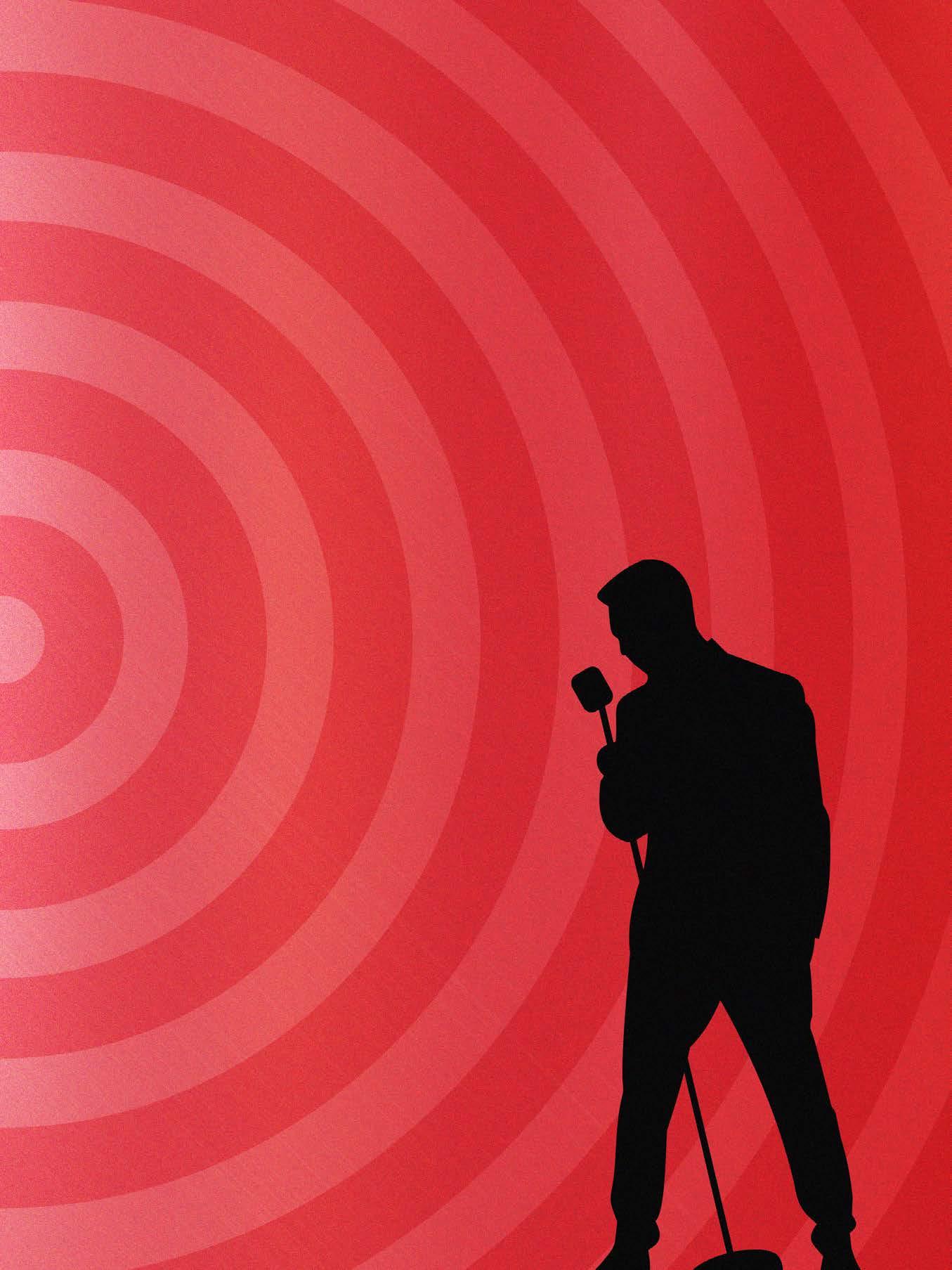
we seem to have shifted to doing the same with men. If the reason female singers have dominated pop music recently is simply because male artists haven’t caught on or refuse to sacrifice more of their privacy, then it is nothing to celebrate.
Pop music possesses qualities that differentiates it from other genres, and can explain why female performers are succeeding. For one, the listeners of pop music are predominantly women, which differs from genres like hip-hop, requiring pop to cater to its audience’s preferences. Additionally, it is a genre fundamentally composed of evolution and changing tastes, something that female artists are adept at navigating thanks to cultural expectations.
Country flips the structure found in pop, with female singers often having to conform to a post-9/11 form of “bro country” music heralded by Florida Georgia Line and Wallen. Instead of a standard of constant reinvention, female country artists are asked to largely stay the same, continuing to play into traditional gender roles and having a harder time finding an audience that wants to hear about something other than alcohol or pickup trucks.
These differences might keep country and hip-hop from seeing the type of landscape in pop music for years to come. But if 2023 represents women truly taking

hold of the expectations of a performer and industry beliefs, then they are in store for a true revolution in music.
• Connor Bedell (Political Science)
39
Designer: Jamie Tishkoff (Business and Design)
While electronic music had been around for a while by the 1970s, no act was quite as formative in its evolution as Yellow Magic Orchestra. Also known as YMO, the underappreciated trio of bassist/ keyboardist/vocalist Haruomi Hosono, drummer/lead vocalist Yukihiro Takahashi, and keyboardist/vocalist Ryuichi Sakamoto was foundational in the development of techno and hip-hop, and practically invented synthpop. Their relevance is as overt as having been remixed and sampled by the likes of Michael Jackson, Mariah Carey, and Jennifer Lopez, but their ingenuity in electronic music has shaped figures from Duran Duran to David Byrne to Arca.

While becoming household names in Japan, YMO was simultaneously the first Japanese group to find success overseas. They defied caricatures of Japanese music — a sound that had become increasingly imitative of Western styles by the 1970s — by defining a particularly Japanese voice of electronic innovation that ended up transcending its borders. Perhaps in another zeitgeist their trailblazing innovation would have made them a quintessential boy band, but comprehensively influencing music as we know it and ushering in “the age of the computer programmer as rock star” makes them as significant. Even if eventually collapsing under internal strife and the weight of the trio’s burgeoning solo careers, YMO’s brief but lush discography is one of cutting-edge singularity.
YELLOW MAGIC ORCHESTRA 1978
With the opening seconds of “コンピューター・ゲーム “サーカスのテー マ” (Computer Game “Theme From the Circus”),” the monumental force of YMO as a fully-fledged band was unleashed upon the world. Its glitchy electronic notes swarm and gush, repeating over slide whistle-esque tones and beats that would belong everywhere from a Pokémon soundtrack to a Kraftwerk record — eventually inspiring both. Yellow Magic Orchestra, and the band as a unit, was formed as a satire of Western Orientalism towards Japan that’s evident in these reinterpreted stereotypical trills of “Computer Game” and throughout the record. YMO encases their own culture in a glittery resin and ships it back across the world — the ephemeral kitsch of “中国女 (La Femme Chinoise)” is an infectious pop tune, but one with a political tilt only three nerdy programmers could pull off so pointedly: “She is the mistress / the scent of the orient.”
Nowhere is this pointed critique of Orientalism as evident as in their debut single and the album’s most significant track, “ファイア
ー・クラッカー (Fire Cracker).” A cover of Martin Denny’s 1959 exotica song “Firecracker,” the trio reinterpret racist notions of Japaneseness through invented electronic sounds. By combining equipment like the Roland MC-8 microcomposer — the earliest popular music album to do so — and Yamaha drums with synthesizers, YMO concocted some of the first synthpop textures. The result is a melange of production decades ahead of its time and themes deeply rooted in 1978 Japan.
“Fire Cracker” itself even charted on the Billboard R&B chart (even from their first release, YMO’s influence extended far beyond what was apparent — their recordings were foundational for hip-hop, being sampled everywhere in the Bronx following the album’s release), while moments like “東 風 (Tong Poo)”’s disco bass has had a far-flung influence on video game music and sound as if they were released yesterday. Yellow Magic Orchestra was timeless in 1978 — and will be timeless for decades to come.
RECOMMENDED TRACKS:“ファイアー・クラッカー (FIRE CRACKER),”“東 風 (TONG POO),”
“マッド・ピエロ (MAD PIERROT)”
Spring 2024 Etcetera 40
SOLID STATE SURVIVOR 1979
With Solid State Survivor, YMO solidified themselves as electronica provocateurs and as some of the most innovative musicians around. Their most commercially successful album, Solid State Survivor is widely regarded as their best work for being future-forward in its unapologetic synthpop. It was much like their debut, albeit with the confidence of now-nationally famous superstars — by 1979, YMO was the biggest band in Japan, often compared to the Beatles as teenage heartthrobs and critical darlings (literally embodying them, YMO covers “Day Tripper” here). The utopian synthpop anthem “Behind the Mask” saw the trio directly influence the international music canon too, with its later Michael Jackson cover validating the group as worthy of mainstream attention.
Much like Yellow Magic Orchestra, Solid State Survivor was a prideful statement of Japanese culture. By the late 1970s, Japan’s
international mystique was reduced to a cyper-futurist enterprise of innovative technology, intertwining it with the Western exoticism YMO satirized in their debut. Here, they revel in their nation’s microchip manufacturing prowess, emblazoning the solid state drive as their sophomore record’s title while remaining on the cutting edge of the technology Japan was frequently reduced to. By incorporating devices like Pollard Syndrum electronic drums and the Moog III-C, YMO grandfathered techno and was the first to use the term in the intro track “Technopolis.” With glittering synths and towering chords flooding its tracklist — all meticulously arranged and composed from their roomful of the newest tech — Solid State Survivor stands as a bastion of the limitless creativity of the new age of computers.
RECOMMENDED TRACKS:“RYDEEN,”“TECHNOPOLIS,”“BEHIND THE MASK,” “SOLID STATE SURVIVOR”
×∞ MULTIPLIES 1980
×∞ Multiplies stands out in YMO’s discography through its sheer outlandishness. The mini-album/EP was even more politically engaged than their previous work, interspersing five comedy sketches performed by the Snakeman Show throughout the record. The sketches mock Western racism towards Japanese people, impersonating business interactions between bigoted Westerners and caricatures of Japanese businessmen. YMO’s righteous anger is personified, particularly following an international tour where they constantly faced anti-Asian racism and xenophobia. Much like their music itself, ×∞ Multiplies’s parody is deeply academic and designed to be extremely uncomfortable.
×∞ Multiplies’s music continued to show YMO’s innovative fervor. They investigate electronic ska in “Multiplies” and feature

grooves now-recognizable as funky house in “Tighten Up,” incorporating each through a distinct new wave sound. The EP is bizarre in its content and composition, but through this strangeness YMO remained a singular force in electronic innovation. Their nuance in pulling off two separate interpretations of Archie Bell & The Drells’ “Tighten Up,” where they demonstrate their technical knowledge but intentionally perform everything “incorrectly,” as if to caricaturize the Western perception of Japanese ineptitude, takes cultural savvy.
×∞ Multiplies may not be the most straightforward or even pleasant listen, but it’s a feat of intertwining art and commentary, all while proving YMO’s unparalleled creativity.
RECOMMENDED TRACKS:“TIGHTEN UP (JAPANESE GENTLEMEN STAND UP PLEASE!),” “MULTIPLIES”
41
BGM 1981
It’s with BGM, YMO’s third official album, that their joy of electronica became fully realized. Unlike the pessimism of Detroit and bleakness of the Düsseldorf scenes, YMO revels in whimsy and fun, crafting computer textures as a weaver’s hands glide over a loom. The title BGM reflects the humor so integral to their ideology and music — its initial for “background music” is a paradox for the noisiness and activity that consumes the record.
Like their previous releases, BGM explores the possibilities of the most advanced and complex computing available at the time — although now enabled with a post-Solid State Survivor success budget. With an equipment budget of ¥51,250,000, or over $700,000 today, YMO explored the minutiae and complexity of software in ways still trailblazing today, particularly as the first group to record with the Roland TR-808 Rhythm Composer after its release that same year, popularizing its now ubiquity. Their full list of gear was affectionately grocery-listed on the back of the LP — functionally a customs
declaration for touring, but artistically a love letter to the machines that make their music. “Tools are not just objects,” according to Sakamoto; their synthesizers and computers were animated in a sense of interrelated beings, part of the YMO organism.
It’s this affection that makes BGM so iridescent. While not as critically or commercially successful as Solid State Survivor the record’s impact on music and independent sonic merit are remarkable. From the novel drum programming in “ユーティー (U•T),” to pioneering synthwave in “マス (Mass),” to early electronic rap experimentation in “ラップ現象 (Rap Phenomena),” BGM casts a long shadow on the industry, past and present. Even the two minute-long opening note of ambient closer “来たるべきもの (Loom)” preceded the iconic THX “Deep Note” — it’s as if the trio was checking off a list of art forms to progenerate.
RECOMMENDED TRACKS:“キュー (Cue),”“千のナイフ (1000 Knives),”“来たるべきもの (Loom)”
TECHNODELIC 1981
Technodelic, coming a mere 9 months after BGM, was an even deeper venture into the bizarre for YMO. The record’s foundation was laid by a new, and even more exclusive, machine — a LMD-649 digital sampler custom built for the group by a Toshiba engineer. Endless pioneers, Technodelic was the first released album to primarily feature samples and loops, a technique that has spawned countless genres from plunderphonics to hyperpop and is now a fundamental part of the entire industry. Their joy of creating is less evident sonically here, but still omnipresent with the richness and complexity of their process of

making. The trio’s ethos of machines as co-authors is what lead to such a bizarre record; the fusion of samples with vocals through a two-way radio, Prophet-5 synthesizers, and their favorite Roland TR-808 leads to even more unconventional sounds than previously imagined. Gamelan, factory noises, and Indonesian kecak chanting, employed with completely novel techniques, are employed with an intentionality that makes Technodelic so singular. As YMO matured, the record also marked a turning point and the end of a remarkable 5-album run.
RECOMMENDED TRACKS:“新舞踊 (Neue Tanz),”“灯 (Light in Darkness),”“後奏 (Epilogue)”
NAUGHTY BOYS 1983
By 1983, tensions within YMO were high. Hosono and Sakamoto practically hated each other, and Takahashi had to serve as a mediator at all points in the creative and professional process. Whether as a result of Naughty Boys coming after a year break for the trio to explore their solo careers — during which Sakamoto starred in and composed the score for “Merry Christmas, Mr. Lawrence,” winning him a BAFTA Award — or due to growing creative differences, YMO only stayed together at the begging of their record label, Alfa.
And Alfa’s begging paid off. Naughty Boys topped the Oricon charts (Japan’s Billboard), the last time for the group, and became a sensation within Japan. Their experimental musings are largely gone, replaced with unabashed pop music that, according to Sakamoto, was essentially following the “music industry manual.” Naughty Boys was YMO selling out to the masses of sorts, but not selling out their
artistry. While not at the vanguard of electronic music quite like BGM or Technodelic, Naughty Boys perfected pop with the immaculate intricacy present in all of their work. The gleeful vocal melodies and glitzy synths of lead single “君に、胸キュン。浮気なヴァカンス (Kimi ni Mune Kyun)” are less innovative than they are comfortable, but still demonstrate the trademark wackiness and technical expertise of YMO. Their Japaneseness is more legible here, too, with the majority of the tracks being sung in Japanese and largely transcending their earlier critical framework of exotica from the Oriental perspective. Instead, Naughty Boys is unapologetically Japanese, expanding what J-pop could be.
RECOMMENDED TRACKS:“君に、胸キュン。浮気なヴァカンス (Kimi ni Mune Kyun),”“Focus,”
“邂逅 (Kai-Koh)”
Spring 2024 Etcetera 42
SERVICE 1983
In Service, however, tensions were manifest. Coming less than seven months after Naughty Boys, the record was more of an obligation after its predecessor’s commercial success than an intentional project. YMO wanted to end their career as a group after Naughty Boys, and the success of their solo careers was enough to justify disbanding.
Much like ×∞ Multiplies, Service incorporates comedy sketches, this time performed by Super Eccentric Theater, or S.E.T., although with a much heavier hand. The seven sketches, doubling the album’s length, are less pointed than in ×∞ Multiplies and function to make the overall listen clunky instead of a critical perspective. The music
itself is still well-produced and technologically advanced synthpop à la many YMO classics, but it’s evident that their hearts weren’t quite in it anymore. Other than the sublime “Perspective” embodying postmodern defeatism (“In the gleam of a brilliant twilight / I see people torn apart from each other”) and to a lesser extent the new wave funk of “以心電信 (You’ve Got to Help Yourself),” Service fades away in the scope of their more progressive work. After a world tour, Service marked the end of Yellow Magic Orchestra as a full-time group.
RECOMMENDED TRACKS:“キュー (Cue),”“千のナイフ (1000 Knives),”“来たるべきもの (Loom)”
TECHNODON 1993
As a one-off reunion album, released under the name YMO as Yellow Magic Orchestra was owned by their former label Alfa, Technodon has been largely written out of the band’s history. It’s easy to understand why — the record’s ambient techno and IDM leanings are a far cry from the technopop fantasies of their most prolific work. But considering the breakneck pace they innovated in their short seven years as an official band, it’s no wonder that their work ten years later is radically different.
YMO are more interested in exploring the minutiae of sound than eclectic electronic compositions on Technodon. Synths warble with anatomical accuracy on “Hi-Tech Hippies”; haunting tones crescendo and crash in “Nostalgia”; otherworldly pockets of samples and vocals fight for space on “Waterford.” Their interests in world music are present throughout their percussion and yields a record more focused
RECOMMENDED
TRACKS:“NANGA

on texture than melody.
But by 1993, Technodon was a small moment in the ever-evolving careers of YMO’s members. During their hiatus and since, Sakamoto became an internationally-renowned and Grammy-winning film scorer and continued releasing music on the forefront `of electronic and ambient; Hosorno transcended into the canon of Japanese solo acts through his countless albums; and Takahashi continued collaborating with other artists as one of the most influential drummers in Japan. To a conscientious listener, practically all electronic, ambient, and hip-hop music has remnants of Yellow Magic Orchestra — few contemporary releases haven’t been touched by these three nerdy programmers on the vanguard of music.
DEF?”“HI-TECH HIPPIES,”“NOSTALGIA”
• Ethan Matthews (Architecture)
43
Designer: Alia Ziae-Mohseni (Computer Science and Design)

An Interview with the Winners of Battle of the Bands 2024
Looking for Rocks
On February 6th, Tastemakers hosted the annual Battle of the Bands for Northeastern student bands to showcase their talent in AfterHours. The audience voted for the winner, Looking for Rocks, after their first ever performance as a band. Looking for Rocks is an indie-rock band made up of Sarah Bernardo (vocals/keys), Kyle Ferris (guitar), Chris Pike (bass), Chris He (guitar), and Adrian Winkelman (drums). Tastemakers sat down with some of the band members to learn more about the band and their quick success.
This interview has been edited for brevity and clarity.
Tastemakers Magazine (TMM): How did you all meet and form your band?
Kyle Ferris (KF): Myself, Adrian, and Chris, the drummer and bassist, have been playing together for a year or two on and off. And then we decided it was time to stop messing around and actually form a band. So we

started practicing regularly and realized we had to find a singer and another guitarist. We finally found Sarah, our singer, on Slack. Sarah had worked with Chris He, our guitarist, before and recommended him.
TMM: Where did your band name come from? How did you come up with that?
Sarah Bernardo (SB): We actually spent so long debating our band name, there’s probably a five-page Google doc with a list of rejected names.
Chris Pike (CP): We spent nights on that.
SB: Yeah, we spent probably weeks on that. And then one night we sat down at a table in Ryder and were like, okay, we just need to choose one. So, we narrowed it down to a few names and then voted on it.
KF: We all really liked “My Seat Last Time” and we all told it to our roommates and they all said it was bad.
SB: “Friends with Consequences” was one of them.
TMM: Is there any sort of meaning behind Looking for Rocks? Where did you get that from?
SB: One time, me and my friends were like, “let’s just try to spew words out.” And then we came up with that one, and then I wrote on the doc, “Get it? Haha.” Because then we can say, “hi, we’re looking for rocks.” And that’s the whole story behind it.
TMM: How would you describe your sound to someone who’s never heard your music before?

KF: Simply put, I’d say indie rock with a little bit of indie pop.
Adrian Winkelman (AW): I would just list Backstreet Lovers.
TMM: Who are some other bands that inspire you?
CP: I’m a big Two Door Cinema Club fan. Peach Pit had some influence.
TMM: You mentioned on stage that Battle of the Bands was the first show you guys ever played together?
CP: Yes. We got our first rock.
TMM: What was it like to have your first ever live performance be a competition? Was it scary?
CP: I was just there to have fun. We weren’t really competing I don’t think. We weren’t going into it with the mindset of “we’re going to win.” We were just like, “let’s have fun with this. Let’s see how it goes.” And I think we rolled with that and we had a lot of fun and we accomplished that goal.
(Communications and Graphic & Information Design)
Designer: Jensyn Ford
Spring 2024 Interview 44

TMM: Were you surprised when you guys won?
SB: Definitely.
CP: Very, very.
KF: I had no expectations for our success. It wasn’t a very competitive vibe. I feel like at the show everyone was very friendly.
SB: Yeah, and it was nice to meet the other bands that are at Northeastern.
TMM: What’s your favorite song to play together?
CP: I like “What You Know” by Two Door Cinema Club. We’re working on that.
KF: I feel like our favorite to play together is probably “Meet My Eyes,” which is our first original.
TMM: For your original songs, what is your writing process like? Are you writing together or is one person taking the lead?
KF: It’s kind of been all over the place

depending on the song. I had mostly written the first song before, and then we put it together. The second song, I wrote part of it and we finished it up together. The third song, Sarah wrote most of it, and we’re putting that together.
TMM: Do you see yourselves playing more shows in AfterHours? Is that something you want to do again?
SB: Definitely.
CP: Any show’s a good show.
TMM: Do you have any shows coming up?
KF: Our show at Hillside Bistro is on April 20th. And we’re releasing “Meet my Eyes” on all streaming platforms. The date isn’t set yet…like mid-April or before the show.
TMM: How is the recording process for that going?
KF: We’re mainly using the Shillman recording studio. I have a recording minor, so we have access to that. We’ve had many sessions and we used a lot of our own gear inside the studio to get it to work. Today,
we’re actually going to go record the bass in Ryder, because there’s no bass amp in the Shillman studio that works.
TMM: Any last words for the people reading?
CP: If anybody is looking to book us…
SB: Reach out! You can find us on Instagram at @lookingforrocks_band.
AW: Should we do favorite rocks?
TMM: Yeah totally.
CP: Granite’s pretty good.
KF: I’ve always been an obsidian lover.
AW: Quartz. It’s nice and clean.
SB: I’m trying to think if I know any other rocks.
CP: I don’t know, you seem like a limestone person.
SB: Yeah. Gotta go with limestone.
(Communications)
• Emily Greenberg
45
Photo Credit: Julia Finocchiaro (Computer Science)

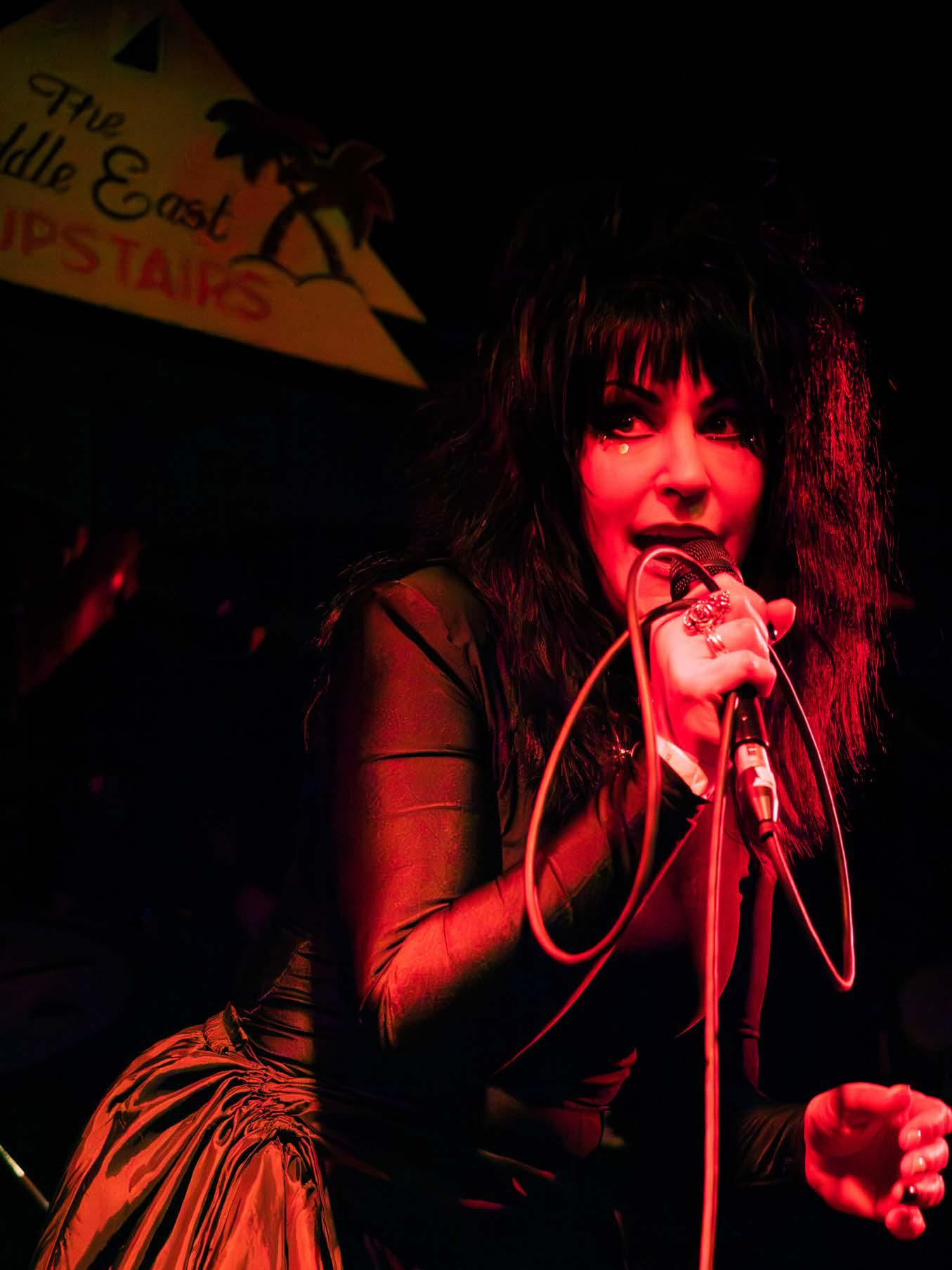 Ghost Painted Sky, Middle East Photo by Maria Angelini (Media Screen Studies and Business Administration)
Ghost Painted Sky, Middle East Photo by Maria Angelini (Media Screen Studies and Business Administration)
UNDERRATED
A journey through the discography of psych-rock trio Spirit of the Beehive (SOTB) feels like falling in and out of sleep while lying on the TV remote. The faint glare of the screen and unintelligible voices flicker and flip as bits and pieces of each channel morph together to put the mind on a journey through discomforting dreams. Every moment is different from the next, and it is all shrouded by a haze of confusion. The lines between dreams and reality blur, and the desire to sharpen them after waking up grows along with the aggravation of knowing that it cannot be done. Every SOTB song morphs constantly and blends into all the others — one moment gentle vocals sing excitedly over a slow uplifting melody and the next everything slows, and the vocals distort before being consumed by feedback.
The group masterfully elicits equal responses of discomfort and intrigue in their sound, a dichotomy which enthralls those that give them a chance. Thoughts are unformed, sentences are interrupted, and random statements are whispered in the background. “THERE’S NOTHING YOU CAN’T DO” is a prime example of SOTB’s elusive nature. At its core a song about the pain of rejection after being led on, the lyrics navigate through blood inside a cup, losing all sense of time, and the repeated screams of “I’ll be your friend.” With no clear thread between the lyrics and the ultimate message, everything feels grounded in uncertainty. The listener is pushed to draw their own conclusions which are often more muddled than the songs themselves. The constant alteration, though confusing, is always clearly intentional.
The musicality that SOTB generates produces a strangley comforting atmosphere. The prevalence of minor chords and unresolved melodies builds the tension that is at the base of their sound. A rapid drum pattern falls over itself at the beginning of “WAKE UP (IN ROTATION)” and from there every sound warps and layers against all the others, coming and going so fast that it feels like falling. Ending with a distorted screech that blends with similar sounding guitars at the beginning of “I SUCK THE DEVIL’S COCK,” SOTB holds the listener in their grasp and only lets them go right before the pressure builds to be too much. There is always a message somewhere in the swirling daze, but it is in no rush to be found. Akin
to astrology or tarot cards, it is best to let intuition lead rather than reason. The more that the hypnosis of SOTB’s sound takes over, the easier it is to discover the depth in their work.
Further supporting the atmosphere of their work are the vocal stylings of Zack Schwartz and Rivka Ravede. They open their mouths and the floor melts, transporting anyone in the path of their voices to another dimension where feelings flow easy. The delivery of most lines contradict what they say, allowing the listener to let their guard down while asking “is the hole we make devouring us?” just as casually as one would ask a friend how their day was. Even while distorted or haunting behind the ever-changing tracks, Schwartz and Ravede refuse to be overshadowed by their production. Their voices are instruments that shift with the dynamic sounds, elevating simple repeated lines like “it might take some time” from bleak statements to touching poetry where nothing could be more meaningful.
Through all the convoluted metaphors and distorted sounds, SOTB occasionally flows out of the darkness to prove they have appeal beyond their eerie front. The song “fell asleep with a vision” is one of their shortest and most effective. Beginning as an 8D audio experience, a quick drum pattern emerges as Schwartz’ distorted voice gets layered with a tight, nostalgic riff. The essence of their sound is perfectly captured within a minute, and as quickly as it appears, the calming tones that began the song return and drown everything out. While “fell asleep with a vision” is a toe dip into the sound of SOTB, “THE SERVER IS IMMERSED” dives full force into it without compromising accessibility. The opening riff is backed by airy synths, and while the song climaxes with guitars that compete for attention layered with intense feedback, SOTB ropes it back in while “dozed on Ativan,” and Schwartz casually lulls any fears of the dark away as the synths return and the song closes.
Across their four albums, SOTB transformed from a run of the mill noise-rock band to a more complex and disturbed group with an energy that is uniquely their own. A step through the door of their sound is uncertain, and their mystery is addictive — the journey is always dark and twisted, but anyone that has a taste would give anything to go on it again.
• TC Stephens (Political Science and Philosophy)





 Designer: Sydney Tomasello
Designer: Sydney Tomasello
47
(Graphic Design)

Feature Fall 2020 48 Spring 2024 Editorial

Just several years ago, if you put “rap,” “cloud,” and “internet” in a Google search, you’d get an assortment of hits about the new wave of hip-hop hitting the airwaves.
Artists like Trippie Redd and Lil Peep, as well as a whole host of up-and-coming rappers, were trying to break through to the mainstream with their lo-fi, often hit-or-miss songs. But venture back a few years more, and you’d upgrade from dial-up to fiber optic: the nascent genre of cloud rap was all the rage, and it would embrace the internet in its visual and sonic aesthetic like no hip-hop subgenre ever had, and ever would again. Upon viewing a picture of a castle floating in the cloud, rapper Lil B infamously declared, “That’s the kind of music I want to make.” It’s an apt description for the genre’s sound, characterized almost entirely by its production: hazy, ethereal, and dreamy, often looping or flipping samples or beats to amplify the singers’ trance-like voices. Where cloud rap’s real essence lies, however, is in its digital footprint, traces of sound and style scattered throughout the internet.
In many ways, cloud rap’s production and sound embodies the endless yet interconnected and layered nature of the internet. Look no further than legendary producer Clams Casino’s discography for a definition of the relaxed and airy style. Cloud rap’s equivalent of a foundational text, the 2009 Clams-produced “I’m God” is an instrumental assisted by vocals from British singer Imogen Heap and is widely considered to be one of the most influential beats of modern rap. “I’m God” exemplifies the very best of the genre; deliberately editing and processing vocals, layered upon themselves to create a druggy, slow, and dreamlike effect without overwhelming the listener. The instrumental has been rapped on by virtually every major cloud rap artist of the 2010s, as well as more unexpected artists like Soulja Boy — evidence of the beat’s transcendence beyond its niche genre. The influence and impact of this innovative production style was immediate; within a few years, Clams Casino and similar producers were making beats for countless stars from Mac Miller to FKA Twigs to The Weeknd. The aesthetic is similarly maintained visually; the album covers of cloud rap stars like A$AP Rocky’s LONG.LIVE.A$AP and Yung Lean’s Warlord embody the slightly druggy, digitally enhanced “looking-through-a-screen” effect that was synonymous with the subgenre’s sound.
As cloud rap’s status rose, so did its interconnectedness with social media, and its most prolific stars used it to reach otherwise unreachable audiences. This predicated the massive role that social media plays in modern music promotion
campaigns — cloud rappers did it first. No artist demonstrated how to use the internet for growth and exposure than Lil B, a cloud rapper who leaned into meme culture and ironic raps to promote his work. For instance, his MySpace usage was credited with keeping the platform afloat long past its prime — in 2010, he uploaded nearly 700 songs exclusively to the site, years after peak usage rates. In a less positive vein, Lil B would often use social media to incite feuds with his peers, trading heated yet comical blows with artists like Joey Badass, Soulja Boy, and others to the enjoyment of his online fanbase. Though more often fabricated for laughs and publicity than legitimate, Lil B’s online scraps are significant because he was one of the first to spotlight what would happen when mainstream artists discovered social media: anyone could use it as a tool for promotion, regardless of major label backing or financial limitations.
When the music industry began its transition into the 2020s, cloud rap had already pioneered the transition to online music marketing that came with it. Cloud rap artists were some of the first to prove how the internet could be used to their advantage. Music collective Drain Gang (which includes Bladee, Ecco2k, Thaiboy Digital, Whitearmor, and Yung Sherman) used their combined influence and online cult following to release music to continued success. Drain Gang used social media
“cloud rap’s production and sound embodies the endless yet interconnected and layered nature of the internet”
to create a focused visual aesthetic and interact with fans, and uploaded music independently to SoundCloud and YouTube, bypassing the need for major distributors. Countless other cloud rap artists released mixtapes to see similar success. For example, A$AP Rocky’s first single, “Peso,” was originally an online leak — typically a death sentence for new releases. But after positive word of mouth spread on blogs and online forums, the song gained popularity and started getting radio play
in New York City. Its success let him go on to independently record music videos, release his now-classic mixtape, LIVE.LOVE. A$AP, and sign his first record deal. Had the internet not facilitated this virality, Rocky’s career may never have taken off. The lesson was clear: the playing field was leveled when the entire internet was at your fingertips, and anyone with the right savvy could find musical success.
Years have passed since cloud rap peaked in the mainstream, but its impact on music promotion will never die: it has never been easier to be an independent artist. Social media apps like Instagram and TikTok let artists reach massive audiences with the click of a button, while streaming services and playlists mean their tracks are just a quick search away. You no longer require major label support to “get your name out”; independent releases are a more viable option than ever, and massive artists like Kanye West, Frank Ocean, and Megan Thee Stallion operate this way. It’s become evident that cloud rap was at the forefront of the music industry’s digital revolution. No hip-hop genre before had put the capacities of the internet to the test. Not only did cloud rap fully incorporate it into its visual and sonic identity with its dreamy, trancelike soundscapes, but it proved that artists of all backgrounds and styles could use it as a platform to communicate with fans, promote music, and bypass the need for a way into the historically exclusive music industry.
Since its mid-2010 peak, cloud rap has fallen out of its former place in hiphop, making room for newer styles and subgenres. Regardless, its influence as the harbinger of the digital age of hip-hop remains unarguable. Had cloud rap artists not paved the way, artists may never have realized the untapped potential that the internet had in leveling the playing field. From its style to how it shaped the advancing internet age of music promotion, cloud rap was truly the soundtrack for the digital world’s adolescent years.
• Gabriel Barbier-Saiah (Human Services/ Criminal Justice)
49
Designer: Maia Delagneau (Interaction Design)
 Waterparks, MGM Music Hall
Photo by Julia Finocchiaro (Computer Science)
Waterparks, MGM Music Hall
Photo by Julia Finocchiaro (Computer Science)

 Rachel Platten, Kings Theatre
Photo by Olivia Watson (Media Arts and Communications)
Danny Brown, Paradise Rock Club Photo by Seha Khan (Psychology)
Designer: Adeline Yu (Business and Design)
Rachel Platten, Kings Theatre
Photo by Olivia Watson (Media Arts and Communications)
Danny Brown, Paradise Rock Club Photo by Seha Khan (Psychology)
Designer: Adeline Yu (Business and Design)
Soundscapes and Substances Drug Use in the Music Industry
It is no secret that drugs and pop stars go hand in hand. Drug use innuendos first emerged as lyrics about cannabis within the walls of 1930s jazz clubs, escalating into the MDMA and cocaine hellfest of EDM and rave culture. What was once an individual issue became an industry-borne issue, rooted in an intense desire for escape in socially turbulent eras of oppression and civil rights struggles. Beyond the seemingly prosaic lyrics of popping pills and smoking cannabis lies the comforting burrow of being under the influence — a reprieve from the pressing demands of fame and society at large. With this, however, comes rising trends of drug-related deaths amongst musicians that bring forth the question of the need for support systems.
Looking back, the 1960s counterculture was a catalyst for the normalization of the recreational drug use we see in today’s music industry. During this era, conflict, censorship, and media control brought about an oppressive atmosphere in the United States. Fueled by televised massacres and violence, the majority of Americans opposed the imperialist nature of the Vietnam War, resulting in a surge of young adults who rejected violence as a means of resolution. In lieu, these young adults embraced pacifism and social change and became known as the hippies. Brimming with colorful visuals, groovy motifs, and peace signs, the birth of hippie counterculture ensued. In response to an era marked by hyperconformity and materialism, the hippies popularized a lifestyle centered around peace and spirituality, driven by a protruding desire for individuality. Psychoactive substances such as cannabis and LSD became a haven for hippies — a metaphysical escape that enabled them to plunge into a mind-altering realm amidst a world rife with violence. Following the widespread protests against the Vietnam War came Richard Nixon’s crackdown on the “War on Drugs” in the 1970s, which demonized drug usage and declared it as “public enemy number one." Drugs became a gateway to rejecting authority and the strict establishment under Nixon’s presidency that disproportionately targeted marginalized communities. The hippies’ reliance on drugs as a means of protest against the US government later molded the psychedelia and acid rock music scene, which placed perception-altering drugs at the forefront of the music experience.
Sonically, psychedelic rock incorporates punchy electric guitar riffs, complete with sound effects such as reverb and distortion, transporting listeners into an ethereal and surreal soundscape. Artists such as Jimi Hendrix dominated the psychedelia scene, which was no longer just a musical genre, but rather a cultural movement. Amidst an era of political turbulence and conflict, the hippies sought solace amongst one another, fostering a collective atmosphere of creativity and autonomy that birthed the classic 70s aesthetic we know today. Hendrix himself was openly anti-war, with songs like “Machine Gun” explicitly referencing the deaths of soldiers in the Vietnam War.
The Beatles, pioneers of the 70's alongside Hendrix, first started experimenting with pills such as Preludin — over-the-counter German slimming pills — to get through long nights of performing. Preludin worked by suppressing one’s appetite and would subsequently give users a burst of energy. Ringo Starr, The Beatles’ drummer, credited the drug as “... the only way we could continue playing for so long.” For many artists, drugs became a necessity to cope with the long, demanding hours as well as being able to maintain stage presence. In some respects, drugs became a sanctuary for artists such as Jimi Hendrix and The Beatles who were openly anti-war and wanted to express their defiance towards authority and oppressive government policies.
Gradually, peace signs and tie-dye hues gave way to mohawks and leather jackets, marking the arrival of punk rock in the music scene. Lyrics became angry, passionate, and gritty, and although seemingly opposite to the peace and harmony the hippie counterculture preached, both genres were borne out of political opposition. The 1980s saw a rise in capitalism where profits were maximized at the expense of workers. Mental health was highly stigmatized and marginalized communities, such as the LGBT+ community, faced heightened discrimination. For many punks, glue sniffing became all the rage — the practice of inhaling household chemicals that produce an alcohol-like intoxication combined with psychedelic visuals.
Spring 2024 Editorial 52
Other punks gravitated to harder, more potent drugs. Heroin, also known as diamorphine, surged in popularity around the 1980s alongside the rise of rock and roll music. Rock artists like Kurt Cobain were known famously to abuse the substance, which ultimately led to his untimely death. Part of its popularity can be attributed to its plentiful supply and thus cheap prices, making it easily accessible. In the late 80s, Mexican cartels started smuggling the drug upstate to Seattle, which was a hub for plenty of grunge and rock artists like Kurt Cobain and Layne Staley. Availability of the drug meant that it was heavily incorporated into the rock and roll scene which was further exacerbated because it fit the rebellious imagery of rock and roll, encouraging young fans to turn to heroin.
During this time, drug culture also left its mark on electronic dance music (EDM). EDM can be traced back to its roots in the late 1980s — underground warehouses known as “raves” where Black and LGBT+ individuals sought solace within the walls of electrifying music and neon strobe lights. Ravers don fluorescent clothing and succumb to the influence of psychedelic drugs — thrusting users into a sensory paradise, complete with entrancing visuals and pulsating bass notes. To some degree, EDM has become a modern reincarnation of what psychedelia was — a drug-centered cultural movement materialized through the innate desire for an escape from reality. Ecstasy, also known as molly, is popular amongst ravers. Under the kaleidoscope of electric lights, ecstasy sends users to stratospheric levels of euphoria and energy. Unlike psychedelics such as LSD which exudes an introspective, calmer influence on users, ecstasy is associated with heightened levels of sociability which is conducive to the high-energy ambiance in raves.
Yet, despite the paralyzing grasp drugs have on many artists, little has been done to improve the crippling grasp drugs have on the industry. For many artists, drugs such as heroin and cocaine have been used as a creative vessel in their songwriting process, encouraging frequent drug use under the guise of creativity. Keith Richards, The Rolling Stones frontman, admitted that heroin greatly aided him when writing songs. He recalls “I wonder about the songs I’ve written: I like the ones I did when I was on (heroin). I wouldn’t have written ‘Coming Down Again’ without that.” Because of the prominence of drug references in music, there is a certain mystique that drugs exude which leaves many artists and fans romanticizing the perilous substances. Additionally, the myth of the tortured artist heavily glamorizes the idea that great art comes out of great pain, which further contributes to the misguided appeal drugs have on society.
While we are quick to point out the dangers of recreational drug usage, it is difficult to break the systemic forces that seem to perpetuate it as a means of forming communities or as a creative vessel. To address this, artists have been vocal about drug rehabilitation campaigns and increasing awareness regarding addiction. Although dismantling such rigid norms in the music industry proves to be complex, opening up conversations about their impact is a step in the right direction.
• Kristina Saavedra (Business Administration)
53
CROSSWORD

ACROSS
2. Who plays Donna's mom in "Mamma Mia! Here We Go Again"?
5. What singer debuted her baby bump at the 2024 Oscars?
7. What Bob Dylan song was covered by George Harrison, Jeff Buckley, and Joan Baez?
8. Who is Miley Cyrus' godmother?
DOWN
1. What artist wrote a parenting advice book called "Dear Future Mama"?
3. Which famous actress is featured on "Mamma" by My Chemical Romance?
4. Whose mom has got it going on?
6. David Guetta's "Hey Mama" features Afrojack, Nicki Minaj, and who else?
1st Row: Mamma Mia, ABBA Certified Lover Boy, Drake If I Can't Have Love I Want Power, Halsey 2nd Row: Household Name, Momma O My, Mother Mother Color Theory, Soccer Mommy Zoomed Spring 2024 Etcetera 54
YOUTUBE PLAYLIST
Inspired by this issue’s cover story on plunderphonics, here’s a sample of some of our favorite plunderphonics tracks from its 1980s origins to today.

ZOOMED
Can you tell which six album covers we’ve zoomed in on?
“dab” by John Oswald
“Since I Left You” by The Avalanches
“I Still Haven’t Found What I’m
Looking For (Special Edit Radio Mix)” by Negativland
“Stem / Long Stem - Medley” by DJ Shadow
“Building Steam With A Grain Of Salt” by DJ Shadow
“Play Your Part (Pt. 1)” by Girl Talk
“Replica” by Oneohtrix Point Never
“abusive” by MIMIDEATH




FIND BEYONCÉ

We’ve hidden Beyoncé somewhere in this issue. Find her and maybe something cool will happen...
“CD Player, Pt. III” by death’s dynamic shroud
“Limbo” by Negativland
“pretender” by John Oswald
“Radio” by The Avalanches
“Fucked Up in the Crib Drinkin Doctor Bob” by MIMIDEATH
“Drink It Up” by Negativland
“Open” by John Oswald
“Sleep Dealer” by Oneohtrix Point Never
“My 36 Favorite Punk Songs” by Jason Forrest
“Midnight in a Perfect World” by DJ Shadow


FOLLOW US
Like what you read? Check us out online.
tastemakersmag.com @tastemakersmag
1. 2. 3. 4. 5. 6. 7. 8. 9. 10. 11. 12. 13. 14. 15. 16. 17. 18.
55












 Tkay Maidza, Brighton Music Hall
Photo by Faith Nguyen (Architecture)
Tkay Maidza, Brighton Music Hall
Photo by Faith Nguyen (Architecture)





















 Jack & Jack, Brighton Music Hall
Photo by Anna Kelly (Health Science)
Jack & Jack, Brighton Music Hall
Photo by Anna Kelly (Health Science)















 Molly Grace, Rockwood Music Hall Photo by Samantha Davidson (Business Administration)
Molly Grace, Rockwood Music Hall Photo by Samantha Davidson (Business Administration)











 Chelsea Wolfe, Royale Photo by Sophie Quisenberry (Journalism)
Sloppy Jane, Crystal Ballroom
Photo by Ula Bitinaitis (Computer Science and Media Arts)
Chelsea Wolfe, Royale Photo by Sophie Quisenberry (Journalism)
Sloppy Jane, Crystal Ballroom
Photo by Ula Bitinaitis (Computer Science and Media Arts)













 Ghost Painted Sky, Middle East Photo by Maria Angelini (Media Screen Studies and Business Administration)
Ghost Painted Sky, Middle East Photo by Maria Angelini (Media Screen Studies and Business Administration)




 Designer: Sydney Tomasello
Designer: Sydney Tomasello


 Waterparks, MGM Music Hall
Photo by Julia Finocchiaro (Computer Science)
Waterparks, MGM Music Hall
Photo by Julia Finocchiaro (Computer Science)

 Rachel Platten, Kings Theatre
Photo by Olivia Watson (Media Arts and Communications)
Danny Brown, Paradise Rock Club Photo by Seha Khan (Psychology)
Designer: Adeline Yu (Business and Design)
Rachel Platten, Kings Theatre
Photo by Olivia Watson (Media Arts and Communications)
Danny Brown, Paradise Rock Club Photo by Seha Khan (Psychology)
Designer: Adeline Yu (Business and Design)









